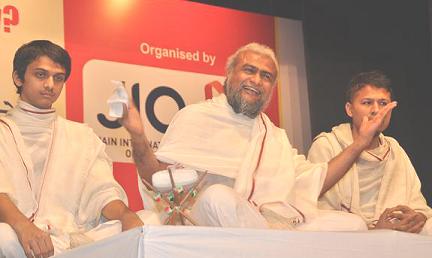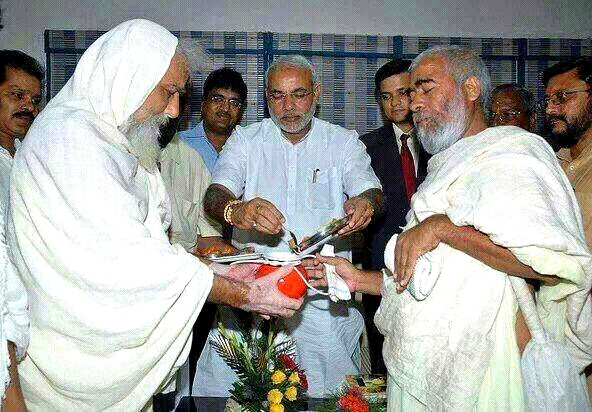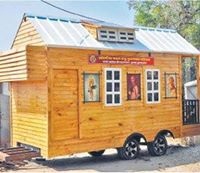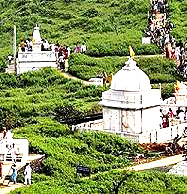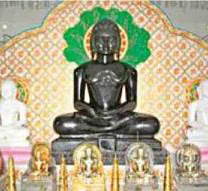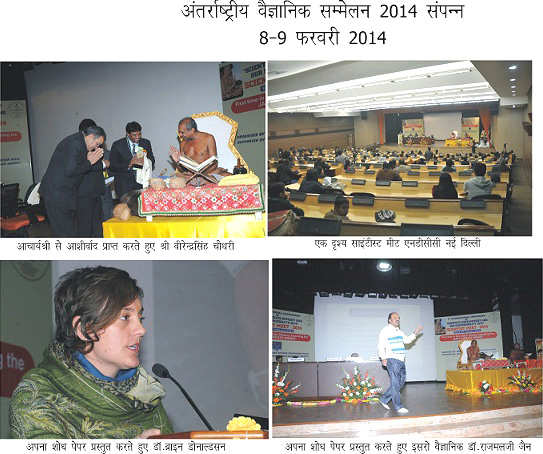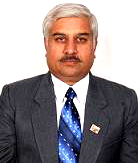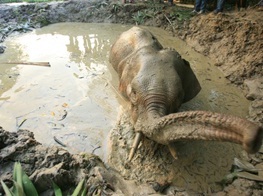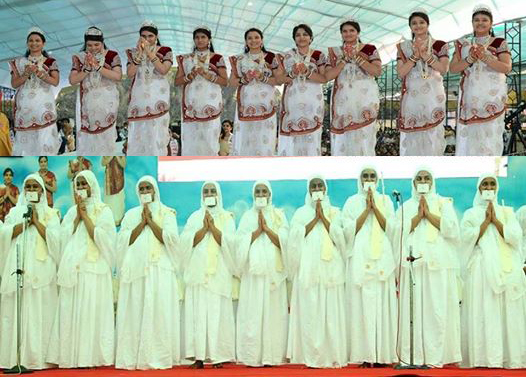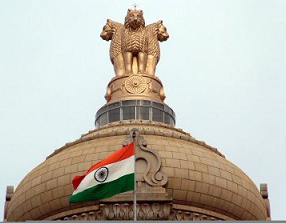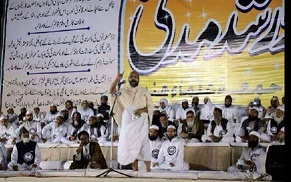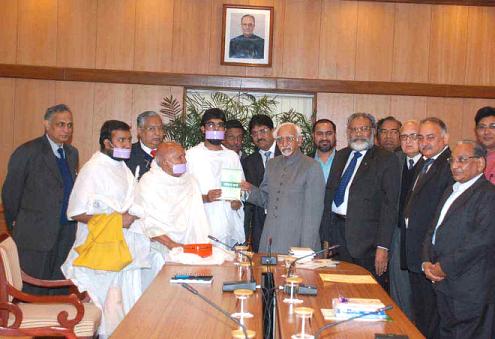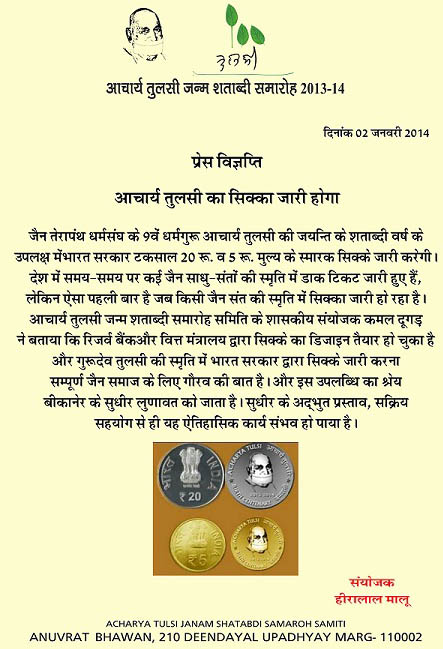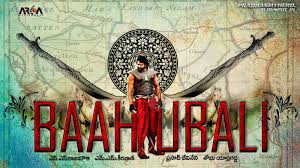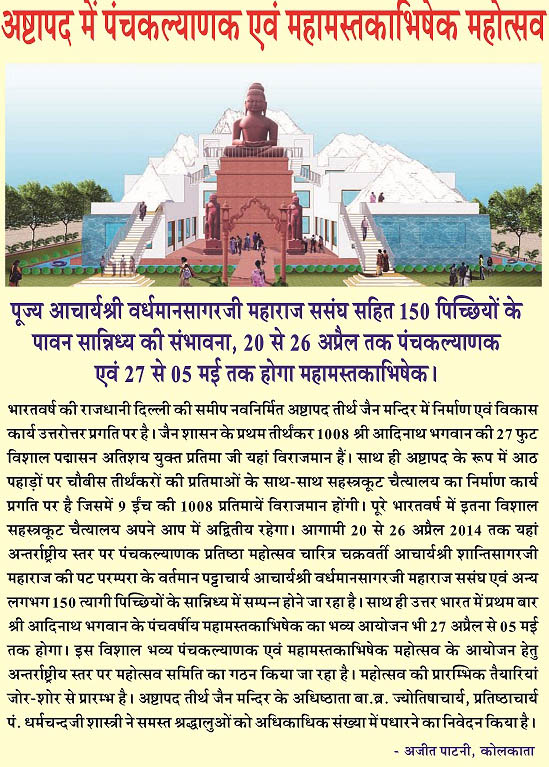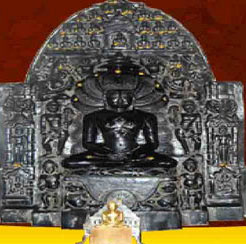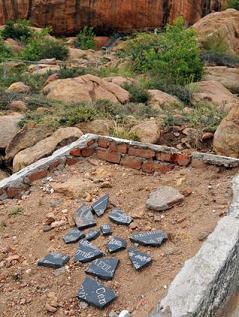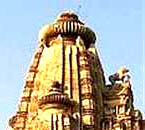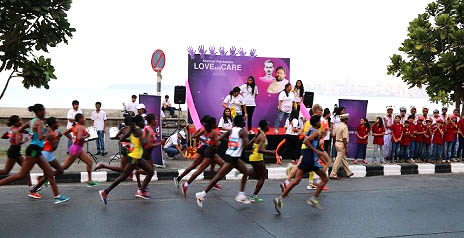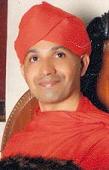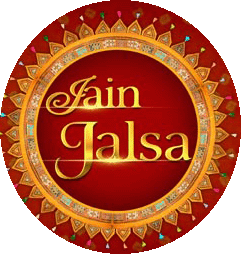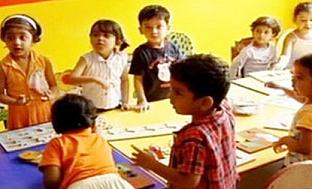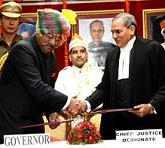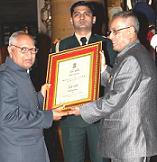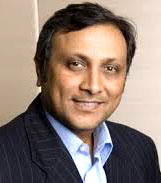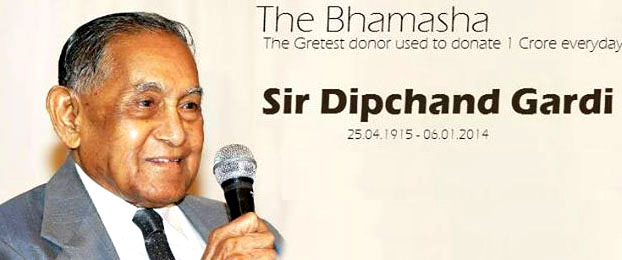PARNA AUCTION GOES FOR RUPEES 21,21,00,000 AT MARINE DRIVE MUMBAI
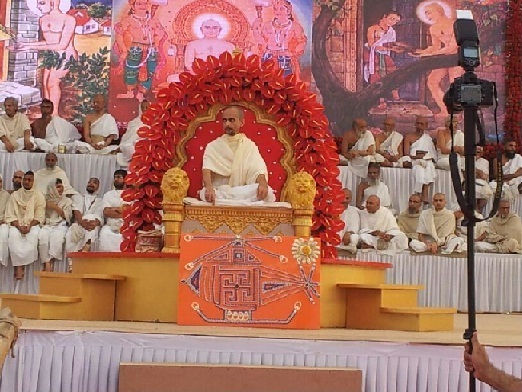
Maharaj Saheb Shri Hasratan Vijayji has completed hundred and eighty days of fasting. This occasion has given the reason for glorious celebrations to his followers and community members. As per the prevalent tradition, the community announced Parna Auction. A big number of followers participated in this auction at Marine Drive Mumbai where Maharaj Saheb was holding his past. It is reported that, the offer of Rupees Twenty One Crore Twenty Lakhs was finally went under the hammer and the successful bidder was Ghoghari Visha Oswal, Smt. Gajraben Girdharlal Jivanlal Shah of Jasparawale. The community offered the family the title of "Nagar Seth". This family is acknowledged for its regular financial and other contributions to the community. The Parna procedure and celebrations were held at Marine Drive Gymkhana in the auspicious presence of Prem Surishawarji M.S., Nayan Padamsagarji M. S. Hemchandji M. S. and Balmuni Vinamra Sagarji. The programme was also relayed live over Arihant Television Channel. Source: Mukesh Nahar Jain, Email:
JAIN INTERNATIONAL ORGANISATION TO SET UP 24 UNIVERSITIES IN THE NAME OF 24 TIRTHANKARS
Feb. 15, 2014. Pujya Gurudevshri Nayapadmasagarji Maharajsaheb, founder of Jain International Organisation announced that JIO will set up 24 universities in the name of 24 Jain Tirthankars, in order to avail benefits of Minority Status to Jains.
|
He was speaking in a function held in Mumbai on 15th February 2014 to honor 3 Central Govt. Ministers for their remarkable contribution in obtaining Minority Status for Jains. These included Central Rural Development Minister Mr. Pradeep Jain “Aditya”, Minister of Minority Mr. K. Rahman Khan & Central State Minister Mr. Milind Deora. The occasion was graced by Pujya Lokesh Muniji, Mr. Mangalprabhat Lodha-MLA, Smt. Shobhana Jain-President UNI, Mr. S. C. Jain (Delhi) and Mr. Subhash Oswal (Delhi).
Pujya Gurudevshri declared that JIO would shortly publish a booklet on information & advantage of Minority Status of Jains. The booklet would also include various legal provisions relating to Minority status.
Pujya Gurudevshri Nayapadmasagarji categorically stated that Hindu was our culture & Jain was our religion. As Jains were respected by all, Jains would play a vital role as a link between majority & minority communities”. Pujya Gurudevshri stated that population of Jains in the world was 40 crore 2500 years ago, which was reduced to 8.50 crore before 900 years and presently it was 46 lacs as per last census by Govt. Jain community had always been peace loving, non-violent & charitable. Thus, there had been many attacks on Jain, being soft target. The Jains were forced to convert to other religions and their temples were also taken away or destroyed. Once upon a time famous temple of Tirupati Balaji was Jain temple. After getting Minority Status, Jains should get back all such converted temples & properties.
|
Mr. Hemant Shah, Prominent Leader of JIO in his welcome speech stated that the Jains would get benefits of reservation & security having got the minority status. Jains would now become a link between majorities & minorities.
Prof. Rattan Jain from Delhi informed that with recent Minority Status given to Jains, protection would be given to their temples, culture, languages & ancient holy scripts, autonomy in management of education institutions, 50% reservation of seats for Jains in Jain educational institutions & professional technical educations, educational loan at concessional interest rate for higher education etc.
Mr. Sudhir Lodha of Chhenai further explained the benefits of Minority Status as a result of which Govt. would provide land and facilities for setting up of Jain educational institutions, properties of Jain Trusts would be out of purview of rent control act, due to which it would be easy to get vacant possession from tenants in the premises etc. Govt. would not be able to interfere or acquire management of Jain shrines or places of pilgrimage.
जुर्म न करने व मांसाहार का सेवन न करने का संकल्प ले - आचार्य ज्ञानसागर जी, तिहाड जेल
दिल्ली की केंद्रीय तिहाड जेल में हजारों कैदियों के सुखद भविष्य हेतु 24 फरवरी को विश्व जैन संगठन द्वारा राष्ट्रसंत जैन आचार्य पूज्य श्री ज्ञानसागर जी मुनिराज के प्रेरक प्रवचन से भविष्य में जुर्म न करने और नशीले प्रदार्थो व मांसाहार का त्याग करते हुए परिवार के साथ सुखमय जिंदगी व्यतीत करने हेतु मंगल प्रवचनों का संयोजन सकल जैन समाज, दिल्ली के सहयोग से किया गया!
|
आचार्य श्री ज्ञानसागर जी ने कहा कि नर जीवन अपने कल्याण के साथ-२ देश, धर्म, परिवार और जनसेवा के कार्य करने के लिए मिला है, न कि दूसरों को सताने हेतु! कई व्यक्ति भूलवश अभावों से पीड़ित होकर या आवेश में आकर अपराध करता है जिसकी सजा केवल उसे ही नहीं अपितु उसके पुरे परिवार को भी भुगतनी पडती है! यदि समय रहते अपने द्वारा किये जा रहे अपराध और उसके परिणाम का विचार कर ले तो कभी भी अपराध न करें! एक बार गलती करके तिहाड में आकर आज संकल्प लें कि यहाँ से रिहा होकर भविष्य में कोई भी ऐसा कार्य नहीं करूँगा जिससे दुबारा यहाँ आना पडे! पंछी को भी चाहे सोने के पिंजरे में कैद कर लो लेकिन वह भी खुले आसमान में उडना चाहता है, आप तो इंसान है, समझदार है! दुनिया का कोई भी धर्म जुर्म करने या दूसरो को सताने की इजाजत नहीं देता!
उन्होंने कहा कि व्यसनमुक्त और अहिंसात्मक जीवन शैली से भविषय को उज्ज्ववल बनाया जा सकता है! भ्रामक विज्ञापनों द्वारा मांसाहार, अंडो और गुटके आदि के बारे में लोगो को गुमराह किया जा रहा है! शक्तिशाली पशुओं में हाथी और घोडे द्वारा मांसाहार नहीं किया जाता है फिर इंसान को इनकी आवशयकता क्यों है?, नशा करने से सोचने, समझने की समझ समाप्त हो जाती है जिसके कारण वह अपराध करता है! आचार्य श्री के प्रवचनों से प्रेरित होकर कैदियों द्वारा बार-2 तालियां बजाकर आचार्य श्री के प्रवचनों की अनुमोदना की गयी और कई कैदी भावुक हो गए और कई कैदियों द्वारा बार-2 हाथ उठाकर भविष्य में जुर्म न करने हेतु संकल्प लेने की सहमति दी गयी!
इस अवसर पर जैन सभा, जनकपुरी द्वारा जेल में कैदियों की सुविधा हेतु एक कंप्यूटर भेंट दिया गया और जैन समाज, नजफगढ़ द्वारा सजा पूरी कर चुके लेकिन जुर्माने न भरने के कारण जेल में बंद अच्छे चाल-चलन वाले दो कैदियों की रिहाई हेतु जेल प्रशासन की सिफारिश पर जुर्माने की राशि जमा कर मुक्त कराया गया! Source: Sanjay K. Jain, Email:
ACHARYA MAHASHRAMAN SCHEDULE GANGASHAHAR - DELHI
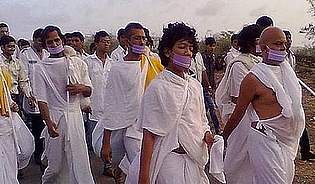

Probable Travel Plan: As per Google Map above
| 01.03.14 - Mahajan 04.03.14 - Rajiasar 07.03.14- Suratgarh 10.03.14 - Pilibanga 13.03.14 - G.R. Global School | 16.03.14 - Shree Ganganagar 19.03.14 - Lalgarh 22.03.14 - Jandavali 25.03.14 - Hanumangarh Town 28.03.14 - Sangaria 31.03.14 - Shergarh | 03.04.14 - Dera Sacha Sauda 06.04.14 - Kanakvala 15.04.14 - Bhikhi 18.04.14 - Bareta 21.04.14 - Ratia 24.04.14 - Jandali | 27.04.14 - Dariapur 30.04.14 - Sirsa 03.05.14 - Sirsa 06.05.14 - Pili Mandori 09.05.14 - Adampur 15.05.14 - Jindal School | 20.05.14 - Biran 23.05.14 - Gurukul 26.05.14 - Kharavad 29.05.14 - Bahadurgarh 30.05.14 - Delhi |
|
जैन मुनि के विश्राम के लिए 10 लाख का मोबाइल हाउस
|
उदयपुर राज./ दिगंबर मुनि प्रसन्नसागरजी महाराज को विहार के दौरान रात्रि विश्राम के लिए अतिरिक्त नहीं चलना पड़े, इसके लिए उदयपुर के एक भक्त ने दस लाख रुपए का मोबाइल हाउस तैयार करवाया है, जो रविवार को गुजरात के दाहोद में उन्हें भेंट किया जाएगा। लगभग दस लाख रुपए की लागत से बना यह मोबाइल हाउस पूरी तरह इको फ्रेंडली है। इसमें मुनिश्री के लिहाज से तथा उनके नियमों को ध्यान में रखते हुए ही बनाया गया है। हाउस के बाहर मुनिश्री की तस्वीरें भी लगाई गई है।
क्या है खास -नॉन मोटराइज्ड बॉडी पर बनाया गया है, जिसमें फॉच्र्युनर के व्हील लगाए गए हैं। पाइन वुड से ऊपरी चैचिस बनाई गई है। जिसमें आठ बाइ आठ के दो कमरे हैं। हाउस की छत पर सोलर पैनल लगा है। जो अधिकतम 110 वॉट की क्षमता उठा सकता है। एलईडी लाइट्स का इस्तेमाल किया गया है तथा हर कमरे में दो पंखे लगाए गए हैं। मुनिश्री के विश्राम के लिए पाटा लगाया गया है। पाइन वुड की खासियत है कि धूप, बरसात का इस पर कोई असर नहीं पड़ता है। बतौर विकल्प एयर कंडिशनर भी लगाया गया है।
कैसे आया विचार -मुनि प्रसन्नसागर जी के भक्त अजय जैन ने उनके साथ अब तक चार हजार से अधिक की पदयात्रा की है। जैन ने बताया कि विहार के दौरान कई बार ऐसी स्थिति बन जाती है, जब मुनिश्री को विश्राम के लिए स्थान नहीं मिलता। इसके चलते उन्हें 10 से 15 किमी अतिरिक्त पैदल चलना पड़ता है। मुनिश्री को अतिरिक्त नहीं चलना पड़े, इसके लिए मोबाइल हाउस बनाया गया है। Source: Ramesh Mehta
असामाजिक तत्वों ने मुनि श्री शिवदत्त सागर जी महाराज पर हमला करा
2 March, 2014, ग्वालियर में त्रिशलागिरी में कल कुछ असामाजिक तत्वों ने मुनि श्री शिवदत्त सागर जी महाराज पर हमला करा जिसमे मुनि श्री को शारीरिक पीड़ा पहुची (उन्हें कई जगह चोटे आई है)। मध्य प्रदेश के मुख्मंत्री कहते है की मध्य प्रदेश में जैनों को अल्प संख्यकधोषित किया है तो ये जैनों के साथ क्या हो रहा है। जैनों में मुनि को चलता-फिरता तीर्थ कहते है। तो मुख्यमंत्री जी आप हमारे तीर्थो (संतो) को बचाने के लिए कदम उठाये।
NEWS ABOUT JAIN TEMPLES
PARASNATH TEMPLE AREA TO BE DEVELOPED INTO TOURIST CENTRE
|
The area where world famous Parasnath Temple is situated in Giridih district will be developed into an attractive tourist destination, Jharkhand government said on Parliamentary Affairs Minister Rajendra Prasad Singh assured the House that the government would develop the pilgrim centre after Speaker Shashank Sekhar Bhokta directed the government for the same. The speaker's direction came following a question by members on construction of ropeways in some tourist spots.The 4,431 ft high Parasnath hill is the highest peak south of the Himalayas. The oldest of the Jain temples is located atop it. Parasnath is the 'Marang Buru' or hill deity of the Santhals of Hazaribagh, Manbhum, Bankura and Santhal Parganas.
But several Jain institutions including temples may not very much appreciate the initiative of the Jharkhand Government as this sacred place for pilgrimage will become crowded and commercial. To an extent the religious sanctity will also be lost. The community must seriously look into the programme of the state government before it is implemented.
JAIN TEMPLES ARE SOFT TARGET FOR THIEVES
February 8, 2014 Indore: A Jain temple in Greater Brajeshwari was targeted by some miscreants, who managed to steal 15 chhatris worth Rs 1.5 lakh under Kanadia police station, on Thursday night. The miscreants also damaged one CCTV camera before committing the larceny.The police are investigating the matter. Investigating Officer said that the accused entered the temple and broke the temple door locks and took away goods. He said that 10 small and 5 big chhatris were stolen. He added that the CCTV cameras installed in the temple failed to capture the theft as one was not functioning due to some technical fault while the other was damaged by the miscreants.
ANTIQUE STOLEN FROM ANGADI JAIN TEMPLES
|
Friday 21, 2014, Mudigere, Chikmagalur district, Ancient statues at the two temples of Lord Mahaveera and Thirthankara, at Angadi in the taluk were stolen. The black-stone statues of Jain thirthankaras Mahaveera, Neminatha, Adinatha and Mallinatha have been stolen from the temples built by the Hoysala dynasty which had Sosevur, now identified as Angadi, as its capital. As renovation of the temples adjacent to each other, was set to begin on February 22, the idols were shifted to a makeshift shed on the temple premises, where they were offered poojas for the past two days. Police said the priest went to the temple after the pooja at the shed on Friday and found the statues missing. A statue of Lord Mahaveera in a sitting posture at the Mahaveera temple and three statues of Neminatha, Adinatha and Mallinatha in a standing posture at the Thirthankara temple, have been stolen, said the police. On receiving the complaint, a dog squad and forensic experts rushed to the spot. Information has been sought from the Department of Archaeology in Mysore for assessment of the value of the statues, said the police.
MAN ARRESTED FOR STEALING IDOL FROM TEMPLE
Feb 11, 2014, Aurangabad: The City police have arrested a 70-year-old man for allegedly stealing an idol from a city-based Jain temple a couple of days ago. A complaint in this regard was lodged after closed circuit television cameras installed at the temple revealed the theft. The arrested accused has been identified as Bhiku Baburao Chintamani, a resident of Kachiwada. Chintamani was an employee of a city-based jewellery shop. The temple authorities then approached the City Chowk police with the footage, following which the police detained Chintamani. During interrogation, he admitted that he stole the idol thinking it to be of gold but it turned out to be of mixed metals. Thereafter, he threw the idol into a nullah, the police said. At the time of going to press, the police teams along with AMC's sanitary workers were still searching for the idol in the nullah.
MOODBIDRI: THEFT IN BADAGU BASADI IN JAINPET
Date: 06 Feb, 2014, Moodbidri: More and more Jain shrines are being targeted by thieves in recent times, obviously for the sake of antiquity of the idols which have high sale value in the international grey market. This town, popularly known as Jain Kashi, has not yet recovered from the shock of last year's theft of a large number of ancient, rare and precious idols, some of them studded with gold and jewel stones. This was another sad day when it was revealed that thieves had got into the 800-year-old Badaga Basadi, where the reigning deity is Chandranath Swamy. Surprisingly, the basadi is surrounded from all sides by houses which was regarded as the best security for it. However, taking advantage of a fused street light next to it and resultant darkness, miscreants climbed over the roof and released the wooden latch and got down into the mantap where the devotees gather to take a bow. They broke open the alms box which was lying there and took away all the money.
EVENTS & SEMINARS
JAIN COMMUNITY CONVERGES FOR FIRST-EVER MILAN IN DUBAI
Dubai, Feb 4: The first-ever Jain Milan programme in Dubai was held recently at India Club Auditorium, Dubai. The auditorium was fully packed with community members enthusiastically gathered in support of the Milan in Dubai. The programme started with a traditional welcome by ladies to Parama Pujya Swasthi Sri Bhattaraka Charukeerthi Panditacharyavarya Maha Swamiji of Sri Jain Math, Moodbidri amidst the beating of drums. Sri Bhattaraka Swamiji inaugurated the event and did the aashirvachana of the first-ever Jain Milan in Dubai. He conducted the traditional Jain puja rituals and blessed the members and the guests.

All the guests including D Surendra Kumar, national executive president, Bharatiya Jain Milan, M S Mruthyunjay, president, Zone-8, Bharatiya Jain Milan, K Prasanna Kumar, executive president, Zone-8 Bharatiya Jain Milan, Pushparaj Jain, secretary, Zone-8 Mangalore - Division, Bharatiya Jain Milan and Frank Fernandes, CEO, Mosaco Shipping LLC Dubai were invited on to the stage and honoured with bouquets.
Later P Devkumar Kambli, president Jain Milan Dubai - UAE rendered a beautiful welcome address and briefed on the formation of the Jain Milan in Dubai and how he was supported by other members in the formation process. P Devkumar Kambli is well-known in social circles around the UAE for quite a long time.
Sri Bhattaraka Charukeerthi Panditacharyavarya Maha Swamiji along with other guests lighted the traditional lamp and inaugurated the function. Later all the guests spoke briefly highlighting the importance of community organisations and the common teachings of every religion.
D. Surendra Kumar, national executive president of Bharatiya Jain Milan in his speech urged the newly inaugurated unit to reach out to more members of the community in the Gulf and also to spread the message of Jainism. He shared his experience and mentioned on how one should seek favour from the government at the right time for the right necessity which will enable uplifting of the needy in the community.
Frank Fernandes began his speech with a fluent recitation of Vedic hymes, much to the pleasant surprise and delight of the audience. He then delivered a good speech referring to the verses in the Gita and the Epics. He concluded that people of all religions must treat each other with respect and incorporate the essence of all religions in their lives. Pushparaj Jain, secretary of Bharatiya Jain Milan, was also present as a special guest. Prasanna Kumar, president of Bharatiya Jain Milan spoke on the duties and responsibilities of members. Mrityunjaya, Jain leader spoke on the various welfare activities of Jain Milan. The new office-bearers were administered the oath on the occasion. Anitha Surendra Kumar, president of the women’s wing of Bharatiya Jain Milan, Devikumar Kambli, president of Jain Milan Dubai were also on the dais along with secretary Sandesh Jain Angadibettu and vice-president B Bharath Hegde. All the guests including Maha Swamiji were felicitated with shawls, garlands, mementoes and fruit baskets. Community leaders of various organisations of the Gulf, namely Satish Venkatramana, Sarvotham Shetty, Satish Poojari, Prashanth Acharya, Shodhan Prasad, Sudhaker Alva, Balakrishna Salian, Herman Lewis and others were present. All these leaders along with the media members were also invited on to the stage and felicitated with flowers.
Later Sri Bhattaraka Charukeerthi Panditacharyavarya Maha Swamiji rendered a beautiful message, calling upon members of the community to tread the path of righteousness and follow the principle of non-violence to lead a meaningful life. He spoke on some of the teachings of Lord Mahavira and their importance in the present world. He ended his speech with Shanti Mantra and blessed the audience. The event continued with cultural programmes compered by Sandesh Jain, secretary of Jain Milan Dubai. Children of Jain community in Dubai presented graceful dances which included folk dance, patriotic dance, classical dance and music.
|
NEW BOOKS
DR. SANJAY JAIN’S BOOK OPTIMAL LIVING 360 RELEASED
Chicago, January 30, 2014. One of the largest and most popular Sports Bars in Chicago has announced that it will be hosting a massive party on February 2nd that includes launch party of the critically acclaimed book Optimal Living 360: Smart Decision Making for a Balanced Life by Dr. Sanjay Jain. Along with the festivities, author Dr. Sanjay Jain will be at the event to sign books and speak to fans.
|
Optimal Living 360 introduces Integrative Decision Making, an approach that focuses on the big picture and teaches you how to make decisions to receive the highest return on investment in life. In the book, Dr. Jain guides readers through the process of isolating their core values using the ASPIRES model. By using his approach and model, he then explains how to improve aspects of life including health, money, and relationships among others.The book has been critically acclaimed and received reviews from outlets including the Library Journal, Publishers Weekly, Foreward Reviews, Kirkus Reviews, and Readers’ Favorite. One review said, “Optimal Living 360 is an easy-to-read guide to intelligent decision making that should enable anyone to get the most out of life.” Optimal Living 360: Smart Decision Making for a Balanced Life is published by Greenleaf Book Group Press and will be available at Amazon, Barnes and Noble, and Sanjay Jain MD on February 3rd.
About Dr. Sanjay Jain: Sanjay Jain, M.D. MBA is an accomplished medical doctor, health expert, life coach, inspirational keynote speaker, and author who has dedicated his life to helping people find their purpose by achieving a meaningful life that they deeply cherish. Sanjay Jain is a US trained, board certified physician with over 15 years of clinical experience. He holds certifications in Diagnostic Radiology, Integrative Medicine, and Healthcare Quality and Management. He is a graduate from the accelerated BS/MD program at The Northeast Ohio Medical University. He has diversified experience in the private practice, academic, and integrated multi specialty settings. He was a former assistant professor at The Ohio State University where he also obtained his MBA at the Fisher School of Business. The combination of which has given him a unique voice and understanding of the many issues we face today in a real and practical sense.
HONOUR & AWARDS
ACHARYA LOKESH HONORED WITH ‘AMBASSADOR OF PEACE’ AWARD IN UNITED NATIONS CENTRE
New Delhi, 3 February 2014: Founder President Ahimsa Vishwa Bharti and Eminent Jainacharya Acharya Dr. Lokesh Muni was honored with ‘Ambassador of Peace’ award for outstanding contribution in the field of promotion of Non-violence, Peace and Harmony during United Nation World Interfaith Harmony Week celebrated in United Nation Conference Hall, Lodhi Estate. It is noteworthy that Acharya Dr. Lokesh Muni was also honored with Communal Harmony Award by Government of India previously.
|
In the program prominent religious leaders of different religions Swamy Chidanand Saraswati President Parmarth Niketan and Sadhvi Bhagwati President Divine Shakti Foundation from Hinduism, Imam Umer Illiyasi President All India Imam Organisation from Islam, Shri Manjeet Singh G.K. President Sikh Gurudwara Prabandhak Committee from Sikhism, Revd. Dr. Clement Rajakumar Chaplain St. Stephen’s College Delhi from Cristianity, Ven. Lobzang Lama President Ashoka Mission from Budddhism and Ezekiel Isaac Malekar from Judaism were present on the occasion.
Honored with ‘Ambassador of Peace’ award Acharya Dr. Lokesh Muni said that Religion brings us together it does not create differences. There is no place for violence, hatred, fear and disgust on the path of religion. He said violence and terrorism cannot solve any problem. All the problems can be solved peacefully through dialogue.
United Nation World Interfaith Harmony Week was organised by Universal Peace Federation –India (UPF India) and United Nations Information Centre for India and Bhutan (UNIC) which was inaugurated by Member of Parliament and Former Deputy Speaker Rajyasabha Smt. Nazma Heptulla. Dr. Chung Sik Yong, chairman UPF-Asia, H. E. Balmiki Prasad Singh, Former Governor of Sikkim, Hon. Eknath Dhakal, Former Minister Government of Nepal, Mrs. Kiran Mehra- Kerpelman, Director of UNIC, Dr. Robert S. Kittel, Director of Peace Education, UPF-Asia addressed the program. Source: Kenu Agarwal, Media Convener, Ahimsa Vishwa Bharti, E-Mail:
DR SANDEEP KUMAR JAIN NOMINATED NOTED ANIMAL WELFARE ACTIVIST
|
Ministry of Environment & Forests, Govt. of India has Nominated Noted Animal Welfare activist and Wildlife conservationist Dr Sandeep Kumar Jain, Chief Coordinator CAPE-India has been Nominated as Member of Animal Welfare Board of India. The Animal Welfare Board of India is a statutory advisory body on Animal Welfare Laws and promotes animal welfare in the country. Established in 1962 under Section 4 of the Prevention of Cruelty to Animals Act, 1960 (No. 59 of 1960), the Animal Welfare Board of India was started under the stewardship of Late Smt. Rukmini Devi Arundale, well known humanitarian wit5h its Head Quarters at Chennai. Functions of AWBI are: to ensure that animal welfare laws in the country are diligently followed, to provide grants to Animal Welfare Organizations and advising the Government of India on animal welfare issues, the Board has been the face of the animal welfare movement in the country for the last 50 years. The Board consists of 28 Members which Includes M.P.s and Govt. Officials apart from reputed Humantarians and Nominees of Animal Welfare Organisations, SPCAs, Veterinary Doctor, Allopathic Doctor, Doctor from Indian System of Medicine, Representatives of Municipal Corporations. The Present Board will be Headed by Retired General (Dr) R.M.Kharb AVSM and Dr. S. Chinny Krishna (Chennai)will be Vice Chairman.
Dr. Jain who is founder of People for Animals in Ludhiana and has been coordinating animal welfare/ conservation organisations in region, has also been Member of Punjab State Board for Wildlife and and has worked actively in region for the Welfare of Animals and Conservation and Rescue of wildlife. He Has already Worked as Executive Member, AWBI (2001-2004) and has been working as Co-opted Member of AWBI in Regional Sub committee.He also worked as Hony. Wildlife Warden (Punjab) and Special Officer,Wildlife Crime Control Bureau (WCCB, Govt. of India). Courtesy: M. Lodha, E-Mail -
AHIMSA
OPEN TRENCHES IN JHARKHAND DEATH TRAP FOR ANIMALS
This is an abandoned well near a village in Jharkhand which has turned into a death trap for elephant calves.
 | |
Many such abandoned wells and irrigation trenches lie open with their walls long crumbled, and weed along the edges hiding them from view. Elephant herds crossing through these areas in search of food and water, have on numerous occasions lost their young calves to these wells, as they unsuspectingly move too close, lose their footing, and get helplessly trapped.The baby does not die immediately. It panics... cries out for help... the mother and rest of the herd try all they can to rescue the calf, but eventually have to leave the fallen calf in the pit to die a slow and painful death. This tragic situation can be avoided by the simple measure of covering up these wells and trenches to ensure these accidents do not happen anymore. Elephants cannot take these steps.
गौवंश हत्या बंदी के लिए मुंडन आन्दोलन
गौवंश हत्या क़ानून की मांग को लेकर जंतर मंतर में दिल्ली में होगा मुंडन आन्दोलन यह आन्दोलन जैन मुनि श्री विद्या सागरजी महाराज और श्री समधी सागर जी महाराज के सानिध्य में रखा गया है इस आन्दोलन में गौ भक्त अपना सर मुंडन करवाकर सरकार का विरोध करेंगे। इस आन्दोलन में महाराज खुद अपना केश लोचन करके इस आन्दोलन में भाग लेंगे। यह आन्दोलन 2 मार्च 2014 को जंतर मंतर दिल्ली में सुबह 9:30 से प्राम्भ होगा। दिल्ली के आस पास से ज्यादा से ज्यादा गौ भक्त इस आन्दोलन में भाग लेकर इस आन्दोलन को सफल बनावे। और जो भाई बंधू नहीं पहुच सकते वो अपने अपने शहर में." गौ बचाओ क़ानून लाओ के विरोध में मुंडन आन्दोलन" के बेनर लगाकर सरकार का विरोध करे। इस आन्दोलन के बारे में अधिक जानकारी के लिए, मुनि श्री जी के नंबर पर सम्पर्क करे - 09650913364 ।
ARTICLE OF THE MONTH
THE JAIN ART OF SPIRITUAL DYING
Death can happen at any time. If you were on a plane that was about to crash and had no hope of surviving, what would your last thoughts be? Besides getting into a safer position in your seat, would you remember your family, your life, or the possibility of an afterlife?
The art of living well is prescribed by almost all religions, but Jainism goes a step further. Jainism teaches the art of dying well. The Buddhist monk Bhikkhu Jagdish Kashyap once said, "I have learnt many things from Buddhism, but I have to learn the art of dying peacefully from Jainism." The same ideas were expressed by the Gandhian thinker, Vinoba Bhave, who actually chose to die the Jain way.
|
In Jainism, the spiritual ritual of dying is known as sallekhana. In old age or a terminal illness, a person practicing sallekhana gradually withdraws from food, medicine, and any other attachments in a manner that does not disrupt inner peace and dispassionate mindfulness. Prayers and scriptures then prepare the person for their passing.
Such a practice is controversial in the West because of discomfort with the decision to control a person's own death. In some Judeo-Christian traditions, choosing to die is considered a sin. This taboo practice is common among Jain nuns and monks, though, and some lay people have followed it, as well.
Jains believe that the soul is a living entity and the body is not. Death marks the transition of this soul from the current body to another, which is reincarnation. Because of this move from one body to the next, Jainism asks that death be embraced rather than feared. It must be considered in a manner similar to changing clothes or moving into a new house.
Dissimilar to suicide, which is often a result of a passionate reaction to something, a person undertaking sallekhana is calm, dispassionate, and aware. Such a person is not eager to meet death but is willing to face it with grace and self-control. Among Jains, preparing for death starts early and is thought about frequently. One Jain prayer says, "I came in this world alone and will leave alone. That is the nature of human life; even kings and ministers and most powerful people will die one day." This is stated in many religions in one way or another. In the Christian Bible, for example, it says: "All go to the same place; all come from the dust, and all to the dust must return" (Ecclesiastes 3:20). Another reflection in Jain texts reads: "I love my family, friends, and this wonderful life. Now it is time for me to detach myself from them and my possessions. Having a human life was a great opportunity. I will strive to take birth as a human again and continue my spiritual growth. I must give up my negative passions of jealousy, anger, greed, ego, and deceit."
Every day, Jains say "Micchami dukkadam" to all living beings they come across. This phrase means: "May all living being forgive me for any harm I may have done to them, intentionally or unintentionally." These are also some of the last words a Jain will say when on their deathbed. Before the advent of modern science, the time and cause of death were often unknown. Advances in medicine now give a terminally ill person the opportunity to predict when death is approaching, narrowing it down to months, weeks, days, or even hours. When this "window of death" is clear, we can practice sallekhana in order to transition to the next life in a spiritual and peaceful way. The first step is to become free from attachments -- more specifically, to renounce all attachment to family, home, and possessions. At this point, the person vows deeper practice of the three principles of Jainism: non-violence, non-absolutism, and non-possessiveness. They pray for forgiveness for any violence committed in this life. The second and final step is, with the support of family, a doctor, and a spiritual guide, to give up food gradually and become immersed in prayers and hymns. The dying person asks family to join them in prayer and to avoid any emotional outbursts that may make it difficult to let go. As humans, we will all face death one day. As a Jain, I know how I will take that journey when the time comes. Each tradition has its own way of preparing for death, and it's important to considering it during your life. In fact, considering how you will prepare for death before it arrives often gives you more appreciation for being alive.
The author, Yogendra Jain is a technologist, a serial entrepreneur, and a passionate practitioner and promoter of the Jain way of life. He started his career at MIT Lincoln Labs and Texas Instruments before founding and operating several successful companies.
READER'S VIEWS
A BIG THANK YOU TO CONGRESS GOVERNMENT - RAM GOPAL JAIN
Jains of India have been notified as Minority Community in the list of already notified five Minorities as per notification attached. All Jains of India should feel obliged to Mrs Sonia Gandhi Chairperson of UPA and President of Indian National Congress Party, Shri Rahul Gandhi Vice Preident of Indian National Congress Party and Shri Motilal Vohra Treasurer Congress party and all in UPA alliance.
|
This has happened due to efforts of Government of the United progressive Alliance Shri Manmohan Singh Prime Minister of India, Shri K. Rehman Minister of Minority Affairs, Shri Kapil Sibbal Minister of Law, Mr. Pradeep Jain Aditya Minister of state Rural and Development, Shri Oscar Fernadez Minister of Transport and Shri Prakash Jaiswal Minister and others in the Government of India. Now as you know that General Elections of India for Lok Sabha are due in May 2014 and Jains of India have the best opportunity to thank practically Indian National Congress Party by casting their valuable votes to Indian National Congress Party Candidates through out India. I request with folded hands to all Jains of India to be grateful to Indian National Congress party and to VOTE for the Indian National Congress Party Candidates in the Lok Sabha Elections due in May 2014. My appeal has the full support of Mr. Nirmal Kumar Jain President Shri Bharatvarshiya Digamber Jain Mahasabha, Ram GopaL Jain, E-Mail:
NATIONAL MINORITY STATUS FOR JAINS FINALLY - SAJJAN RAJ MEHTA
We have been denied Minority status so many years though as per Indian census 2001 we are just 42 lakhs among 100 crore enumerated.. What we get through Minority status is right to establish and administer our temples, institutions, educational trusts, museums, preserve our culture, heritage and belief to the best of our own hands without Government interference.
Just think for a moment and calculate money spent by Jain samaj all over India on temples, sthankas, bhavans, educational institutions, Goshalas, medical hospitals, dispensaries, pinjarapoles, ancient heritage, monuments, book banks, blood banks, artificial limbs centers, research centers for Jainlogy and administrative training foundation. As per consensus it is believed that in last 66 years since independence our community has spent more than 100 billion rupees in various assets and institutions and every year as per conservative estimate we spend almost Rs. 25000 cr in charity. Most of us have done all these selflessly, out of compassion and empathy. Times have changed since independence We don't have quality of leadership which respects our ethos, sacrifices. Most of political class fight for power to amass wealth at the cost of people, They can pass any order and take over all our assets by a stroke of pen. But if we have Constitutional status of Minority, we have protection and they will not dare to harm or hurt us.. We are a peace loving community. We cant fight like others do. We can only file court cases when our assets come under challenge but the way our system works, it will take 30-40 years to get justice and by that time all our assets will be squandered. What answer we will give to posterity and our departed souls of ancestors if we cant preserve them?
Just think: Girnarji in Gujarat is our sacred Tirth for ages. Our 22 nd Tirthankar Lord Neminathji attained Nirvana but two of hills have already been taken over by vested interest as some agitation was engineered saying he was God of tribals. The objective is to loot forest wealth. What is heritage to us is just wealth for some one. Time has come to think afresh. We should claim our rightful constitutional status not for gaining employment or some benefits but to preserve our religion, heritage and culture for posterity. We are already reduced to small numbers but what is in free store for future should cause ripples within us. Please support usand highlight the success of the agitation as we all have a collective duty towards our culture and heritage to protect and administer what we created out of sweat. Source: Sajjan Raj Mehta.. Chairman Jain Co-Ordination Committee, Mobile - 9845501150.
JAIN MINORITY STATUS - CONFUSIONS, FACTS AND MYTHS - RAJESH JAIN
A farmer lived in a village of Himachal Pradesh adjoining the Punjab Border. There was border realignment and the village was made a part of Punjab. The villager heaved a sigh of relief and said to his fellow villagers, “Thank God, we shall no longer be required to bear the cold weather of Himachal Pradesh.” The reaction of many people to the granting of the minority status to Jains by the Central Government is akin to the reaction of this farmer if the expectation is of Jains getting some extraordinary privilege due to the minority status. Jains already had minority status. In as many as 13 big states of India including Maharashtra (which has the largest population of Jains in India), Karnataka, Madhya Pradesh, Uttar Pradesh, Jharkhand, Delhi, Uttarakhand, West Bengal, Andhra Pradesh, Punjab and Assam, Jains already had the minority status. In all probability, for most Jains and non-Jains it didn’t make much of a difference. Another case in point is the following message which is widely in circulation through social media:
* Who can donate to a donor?
* Jains are 0.40% in number but 26% of Income-tax is paid by them
* 62% of the donations are made by them
* Does such community need governmental alms?
* I am a Jain, but before that I am a Hindu, and before that I am an Indian
*I am not a minority
It is tragic to notice how misguided and gullible a few people among the most literate community of the country could be. Many people are confused and they are misguiding all Jains and non-Jains. They seem to have limited understanding of facts, Jain history and philosophy or they have some hidden motive or they are feeling insecure caused by reactions of others. They have no understanding of the meaning of the minority status. They seem to be equating it with reservation. They are finding it difficult to convince themselves and instead of responding with conviction, righteousness and logic; they are reacting in an immature manner and in undue haste. Except Parsis, I have no doubt in saying that Jains, despite having no Gods who can give boons or bestow wealth and wisdom, are the most well-off (in terms of average income) and the most literate (94.1% as compared to the national average of 64.8%) community of India. But it is preposterous to say that Jains, who are such a small minority, contribute 26% income tax. (I have not been able to find an authentic source for this information. Some write 20%, some articles mention 24%. An Income-Tax Commissioner denied availability of any such data). Statistics is a science of accurate measurement. Fact is, hardly 15-20 companies out of the top 500 companies in India are owned by Jains. Jain companies or names rarely appear in the list of top 10 tax payers. There is no basis to say Jains give 62% of all donations in India. Look at South Indian businessmen and temples. Please also take into consideration the practice of charitable giving among Muslims and Christians.
By making such statements, the plight of the needy Jains is getting undermined and the ego of non- Jains is justifiably getting hurt. Such statements are loaded with motives, are counterproductive and provide false arguments to the ignorant opponents. At the fundamental level, even Hindus look at Jains as different from themselves. They categorize or group Jains not with various castes or with various sects of Hinduism, but with other religions like Muslim, Sikh, Christian, Buddhist and Parsi. They don’t worship Tirthankaras. This proves that Jainism is a separate religion and not a part of Hinduism. We are Jains, and we are Indians, but we are not Hindus. Just because few Jains worship Ganesha and Lakshmi, all Jains cannot be called Hindus. Many Hindus go to Dargah-e-Sharif at Ajmer and the kids studying in Christian schools develop the habit of making a cross on the chest or celebrate Christmas and wait for Santa Claus. Does it mean they are no longer Hindus?
Moreover, these people are asking - Does such a community need governmental alms? Minority status is not so much about getting some benefits and privileges; it is about getting protection and ensuring preservation of culture. It is not at all about reservation. My friends should note that the biggest beneficiaries of reservation are Hindus. Let me present some more facts before you: 1. Muslims, Sikhs, Christians (who are much larger in number) and Buddhists; and Parsis (who are by and large well to do) were already enjoying the minority status since a long time. Did it affect you or did you even know this? If Muslims, Sikhs and Christians are considered minority, why not Jains who are only (0.4%) of the population? If Parsis are ok with minority status despite their affluence, why do some people feel they have been downgraded with the tag of minority status? 2. Hindus enjoy the highest reservation. In India SC (15.00%), ST (7.50%) and OBC (27.00%) enjoy 49.50% reservation. This reservation has absolutely nothing to do with the minority status. The largest beneficiaries of the reservation system are Hindus. With due concern for the poor and needy, I must say that talented but financially weak Jain youngsters are as much the victims of this social and political menace which India has not been able to get rid of despite over 65 years of independence.
Religion-wise break up of beneficiaries for SC and ST categories are as follows:
| Religion | Scheduled Caste | Scheduled Tribe |
| Buddhism | 89.50% | 7.40% |
| Christianity | 9.00% | 32.80% |
| Sikhism | 17.00% | 0.90% |
| Hinduism | 22.20% | 9.10% |
| Jainism | 0.00% | 2.60% |
| Islam | 0.80% | 0.50% |
It is obvious from the above table that Buddhism had almost become extinct in India before some people of Schedule Caste converted to Buddhism. Few tribes, who constitute 2.60% of the total Jain population, get the benefit of Reservation. But the fact remains that Hindus are the largest beneficiaries of the Reservation system. I am still searching for religion-wise data for the OBC category but you can clearly see from the above table that the biggest beneficiaries of reservation are Hindus. Upper caste Hindus fail to recognize that non-Hindus suffer as much as they do due to the issues associated with Hinduism. Unfortunately, people are trying to remain politically correct, even if it is at the cost of being principally and factually wrong.
Definition of Minority
Indian constitution doesn’t define minority - According to a definition offered in 1977 by Francesco Capotorti, Special Rapporteur of the United Nations Sub-Commission on Prevention of Discrimination and Protection of Minorities, a minority is: “A group numerically inferior to the rest of the population of a State, in a non-dominant position, whose members - being nationals of the State - possess ethnic, religious or linguistic characteristics differing from those of the rest of the population and show, if only implicitly, a sense of solidarity, directed towards preserving their culture, traditions, religion or language.” Jains are numerically inferior, different from other religious communities and want to preserve their religion. Jains are minority. UN declaration says that states should protect their existence. It is also an anthropological requirement that ethnic diversity is maintained, otherwise the culture of sameness will make everything stale and boring. Jains are a minority and it is a fact. We look up to all our non-Jain brothers and sisters to relate with our need to preserve our religion and culture.
Some More Facts
1. Jains are very small in number (0.4% as per census). This figure is not correct as many Jains for centuries have stopped identifying themselves as Jains. Paul Dundas writes that as far back as in the Census Report for the Punjab of 1921, permission was given to record such Jains as "Jainhindu", which in his opinion was an 'unhappy and artificial compromise". Still Jains are in a very small number as compared to national and international population.
2. The proportion of Jains has declined drastically over the centuries. Once a major religion, Jainism declined more particularly after the 7th Century due to a number of factors including suppression by other religious groups, persecution, withdrawal of royal patronage, sectarian fragmentation, difficult religious practices, political necessity to identify with the majority and the absence of central leadership.
3. Jains are further decreasing in terms of percentage of population. Census of 2001 brings to light
two alarming facts as can be seen in the following table –
| Religion | %ge of 0-6 age group to total population of the community | Child Sex Ratio |
| Hindus | 15.60% | 925 |
| Muslims | 18.70% | 950 |
| Christians | 13.50% | 964 |
| Sikhs | 12.80% | 786 |
| Buddhists | 14.40% | 942 |
| Jains | 10.60% | 870 |
| Other Religions | 18.00% | 976 |
| India | 15.90% | 927 |
Proportion of population in the age group 0-6 to total population offers a general picture of the relative fertility status among the religious groups. While the proportion for all-India is 15.9 per cent, Jains exhibit the lowest rate at 10.6 per cent. Hindus have 15.6 per cent. On the other hand, Muslims have the highest proportion of 18.7 percent. Jains have adopted birth control due to higher literacy rate. But they are also shrinking fast proportionately. But more serious is the issue of Jains not having awareness of their great legacy and inability to practice and identify with Jain principles, values and practices. If culture is not protected, Jainism will soon be facing the threat of extinction, just like Parsis.
The child sex ratio is 927 for all India in 0-6 population group, signifying great imbalance in future male-female ratio. Among Jains the ratio is only 870 which is 57 points below the national average of 927, which is a very alarming situation.
Jains are a distinct religion, very different from Hinduism. Paul Dundas writes that most British judges of the 19th century "had no doubts about the independent nature and origin of Jainism". In 1847, one judge wrote that religious minorities like Jains, Parsis, and Sikhs "Had nothing or next to nothing in common with brahmanical worship". Indian Census and the Supreme Court on numerous occasions have recognized Jainism as different from Hinduism. Dr. Herman Jacobi said, “…..let me assert my conviction that Jainism is an original system, quite distinct and independent from all others; and that therefore it is of great importance for the study of philosophical thoughts and religious life in ancient India.
”Jains want to preserve their identity, philosophy and culture. This is the reason many distinct Jain organizations are formed. This is the reason we try as much as we can to marry our children within the community. We worship Tirthankaras and have our own Shashtras or Aagam.
A Hindu has to belong to a caste. If Jains were part of Hinduism, which caste would they belong to? While most of the Jains are considered to be baniyas, the Tirthankaras were kings and warriors. Many Jains have made great philosophical and intellectual contributions.
While comparing with Islam and Christianity, Hinduism is presented as a religion. On the other hand, while comparing with Jainism and Buddhism etc., Hinduism is presented as a way of life.The argument is not consistent.
Quite often, people ask - “when did Jainism separate from Hinduism?” It is like asking, “When did your wife stop beating you?” There is an assumption that Jainism is an off-shoot of Hinduism. This is not correct. Dr. S. Radhakrishnan, the great philosopher has written, "There is nothing wonderful in my saying that Jainism was in existence long before the Vedas were composed.”
Hindus are a minority in these 7 states
| Region | Hindus | Total | % Hindus |
| Manipur | 996,894 | 2,166,788 | 46.01% |
| Arunachal Pradesh | 379,935 | 1,097,968 | 44.60% |
| Punjab | 8,997,942 | 24,358,999 | 38.94% |
| Jammu and Kashmir | 3,005,349 | 10,143,700 | 34.63% |
| Meghalaya | 307,822 | 2,318,822 | 29.27% |
| Nagaland | 153,162 | 1,990,036 | 9.70% |
| Lakshadweep | 2,221 | 60,650 | 7.66% |
| Mizoram | 31,562 | 888,573 | 6.58% |
Many groups are demanding minority status for the Hindus in these states for the last many years.
The Key Benefits - The key benefits of the minority status are in terms of more protection to Jain temples and practice of Jain religion, more freedom in managing and maintaining religious and educational institutions, the right to reserve 50% seats of Jain run educational institutions for Jain students and in being able to share certain grants available to minorities. Jain saints will be able to move more freely across the country with more arrangement of security from the state. The recent frequent attacks on them and encroachment of the Jain temples were major areas of concern.
Disclaimer - Let me clarify that I have no intention of offending my brothers and sisters belonging to other religions. Jainism’s motto is parasparopagraho jeevaanaam meaning all lives are bound together by mutual support and interdependence. Moreover, one of the fundamental tenets of Jainism is anekaant or non-absolutism) which recognizes that truth often is multisided and relative and with our limited knowledge we all know only partial truth. In simple terms, it means we shouldn’t get stuck in “ism” but talk in the more accommodative language of “may be”. This is very well illustrated through the story of six blind men and the elephant. Unfortunately, even many Jains are not aware of these powerful and contemporarily relevant philosophies of Jainism, which are essential for the modern world along with Ahimsa (non-violence) and Aparigraha (non-accumulation) to deal with the burning problems like terrorism and violence, environmental problems and mental stress. Let me also emphasize that Jains relate very well with their Hindu brothers and sisters and celebrate many rituals and festivals together. The proximity has led to submergence of the Jain identity into Hinduism and has led people to falsely believe that Jainism is a branch of Hinduism.
Nothing can be farther from truth. Jainism doesn’t believe in a creator God and normal human beings are supposed to reach the highest level through qualitative improvement. All religions of the world speak of God coming to the earth to rescue his children. Jainism talks of promoting normal human beings to Godly levels. History will testify that Jains have rarely forced their philosophy and religion on others. Jainism has not been an aggressor, but mostly been a victim. No wonder, it is on the verge of extinction and despite having a glorious past, as evidenced by presence of old temples and statues across India and an extraordinarily scientific and contemporary philosophy. “Jainism’s important tenets are based on science. The more science advances, the more Jainism will be proven true” - L.P. Tessitori). But for this to happen, Jainism will have to at least survive. It has enough appeal for the young inquisitive mind provided one is willing to go full length in the search of truth and meaning.
Conclusion - George Bernard Shaw is attributed to have said, "I adore so greatly the principles of the Jain religion, that I would like to be reborn in a Jain community." If Jainism is allowed to submerge and lose its identity, I wonder how Bernard Shaw’s wish will ever come true. The tragic part is that most Jains are not aware of their immensely valuable and rich intellectual, cultural and philosophical legacy.. They fail to look at Jainism beyond vegetarianism, having Jain Menu in restaurants and during flights and not eating after sunset. Jainism is much deeper and amazingly enlightening to people having spiritual quest. It doesn’t disappoint a true seeker. It is a contemporary philosophy. The need is to look at true Jainism beyond the rituals. The global society needs Jain philosophy to survive. Let us not be principally incorrect in the desire to be politically correct. Let us also not feel that it is humiliating in any manner to be identified as a minority. It is an existential issue for Jains, of course not as a human species, but definitely as a distinct enriching culture. Human excellence, qualities and social richness is identified through differentiation, in allowing different religions and cultures to coexist, and not in aggregation. In the development of the Indian culture, Jains have been the contrarians and the unifier, the catalyst and the binder.
It must be understood that a minority may disappear from a society via assimilation, a process through which a minority group replaces its traditions with those of the dominant culture, sometime by force and sometime in its need to appease the significant others. We are all idealists when it concerns others and lament why others are not liberal and broad minded, while remaining rigid about our own religion and culture. To my brothers and sisters in majority, I will say this - “If need be, I can die for you; but allow us to live in our own way.” To my fellow Jains, I would say - “please be firm with the values and be flexible with the practices.” For God’s sake (in which we Jains don’t believe), please try to understand true Jain values and principles. I hope the Indian society will accept with tolerance the fact that Jains are actually a minority and that it is not so much an issue of getting some kind of political mileage. Jains will never behave like a votebank and are intelligent enough to stand for what is good for the country, though each individual will express his political ideology in his own way with which you may or may not agree. “Our culture has accepted two huge lies. The first is that if you disagree with somebody’s lifestyle, you must fear or hate them. The second is that to love someone means you agree with everything they believe or do. Both are nonsense.”
We all are different and need not agree to everything about each other. The pillar of a thriving democracy is the statement - “I may not agree with you, but I shall fight for your right to speak.” Let the Indian democracy have all the colors of the rainbow and the Indian culture the requisite variety that protects it from being stale. Source: CA Rajesh Jain, Author & Editor, Janus Advisory Services, Kolkata 700017, E-Mail: , Mobile: +91 98360 80488, Courtesy Sahu R. P. Jain, E-Mail:
MISCELLANEOUS
ENTREPRENEUR NAVEEN JAIN EDGES CLOSER TO CLINCHING THE $40 MILLION GOOGLE LUNAR XPRISE COMPETITION
Washington, DC: Billionaire entrepreneur and space visionary Naveen Jain is one of three key backers behind a Google Lunar XPrise team that is leading competition in all three key areas of consideration. Naveen Jain along with Bob Richards, one of the original co-founders of the International Space University back in 1987, and Barney Pell, a former manager at the US National Aeronautics and Space Administration (NASA) are at the helm of Moon Express, a team that is one of the leading contenders of the Google Lunar XPrise competition.
|
The goal of the competition is to have teams create a spacecraft that can do the following three things: make a soft landing on the moon, detach a lunar module that can travel a minimum of 500 meters on the moon’s surface, and develop an imaging system that can transmit a high-quality picture and video feed back to Earth.Moon Express is one of only two team to have received “milestone prizes” in all three of those categories (Landing, Mobility, and Camera, as the competition calls them); the other is Astrobotic, which is headed up by Carnegie Mellon University robotics professor William Whitaker. Another Indian-fronted team, Team Indus, has received the milestone prize in the categories of landing system and imaging system - only two and three other teams have been named in each field, respectively. The competition was first announced in 2007, with teams finalized in 2011.
The originally 33 have been whittled down to 18, a result of some dropping out and other joining forces with each other. Each category has its own prizes - for example, the team with the best landing system stands to win $1 million - with a total of $40 million being given out by Google. Naveen Jain has been at the forefront of privatizing space travel in an effort to cut through governmental red tape and allow more innovative people in the private sector to advance the stagnating field of space exploration.
REVIEW OF MEAT EXPORT POLICY BY RAJYA SABHA
The petition was admitted by Hon’ble Chairman, Rajya Sabha on 7th January,2013 under the provisions of Chapter X of the Rules of Procedure and Conduct of Business in Council of States (Rajya Sabha). In accordance with Rule 145 ibid, the petition was reported to the Council on 26th February, 2013 by Secretary-General after which it stood referred to the Committee on Petitions for examination and report in terms of Rule 150 ibid. 3. The Committee issued a Press Communiqué inviting suggestions from individuals/organisations on the subject matter of the petition. In response thereto, the Committee got overwhelming response and more than ten lakhs memoranda were received by the Secretariat. The Secretariat scrutinized those memoranda and a gist of the same has been suitably incorporated in the Report. To read more further please click here...............
DIKSHA NEWS
MUMBAI WITNESSES BIGGEST DIKSHA PROGRAMME
|
It was probably first occasion, when nine highly educated girls inspired by Namra Muniji Maharaj of Jain Sthanakwasi Sect took Diksha at Ghatkoper, Mumbai on 9th February,2014.
The programme which was organised at Ghatkoper, Mumbai was attended by several thousand ardent followers from community and other religion as well. Several saints of all the four sects also blessed the candidates by their presence at the venue. Shri Praveen Rishiji, Shri Manohar Muniji, Shri Divakar Muniji and Shri Namra Muniji delivered poignant speeches to make the atmosphere emotional. Namra Muniji introduced all the candidates.
It is reported that, diksha programme was attended by one hundred eighty two saints of four sects and one hundred eighty nine Jain Sangh from different parts of the country and thirty one thousand community members.
Rupees twelve crore were collected as donations. Rupees nine crore were collected for the welfare of Jain saints. The programme which lasted over nine hours was also relayed live through television channels.
HIGH COURT TO HEAR PLEAS IN FAVOUR OF CHILD DIKSHA
Feb 23, 2014, Mumbai: Bombay high court is slated to hear petitions asserting that child diksha or renunciation is a practice integral to Jainism and challenging the authority of child welfare committee to step in to protect young girls.A division bench of Justice V M Kanade and Justice Girish Kulkarni will hear petitions filed by Ashok Bagricha and others challenging the jurisdiction of the child welfare committee (CWC). In March 2004, the diksha ceremony in which the 8 yr-old girl renounced the material world created a furore among child rights activists. It was brought to the attention of CWC by Childline, an NGO. In July 2006, the HC had directed CWC to find whether she had taken diksha voluntarily or was forced. CWC reported that the young girl needs care. Her parents challenged the CWC's order in the HC, which granted a stay on it. Bagricha's advocate had argued in November 2011 that dikshais a practice which is integral to the practice of Jain religion and CWC has no right to step in an extend its protection which is otherwise made to destitute children to a child who on own volition opts for diksha. He had also argued that Jainism was founded in 7 th Century BC, is a religion of sophistry where individual salvation is through individual upliftment and one of these is through child diksha.The judges had then directed affidavits to be filed by two sects of Jainism - Shwetambar and Terapanth - including those of experts on the issue.
DEV LOK GAMAN
शासनश्री साध्वीश्री राजकुमारीजी सुखद संयम पर्याय पूर्ण कर हुयी राज(मोक्ष) पथ कि और अग्रसर
|
शासनश्री साध्वी राजकुमारीजी गोगुन्दा का दिनाक ०२:०२:२०१४ सुबह ५ बजकर २ मिनट पर चौविहार संथारे में अरिहंत चरण.कालूगुनी द्वारा दीक्षित तेरापंथ धर्म संघ कि दीक्षा पर्याय में विशिष्ठ शासन श्री साध्वी राजकुमारी गोगुन्दा का 93 वर्ष आयु में चौविहार संथारे में देवलोकगमन हो गया! आपश्री कि दीक्षा संवत 1985 में कालूगणी के हाथो पडिहारा में हुई थी! दीक्षा के समय आपश्री कि आयु 8 वर्ष 7 माह और 14 दिन कि थी! आपका जन्म संवत 1977 को हुआ था! साध्वी राजकुमारी गोगुन्दा ने अपनी माँ साध्वीश्री फुलाजी के साथ दीक्षित हुई थी! आपने साध्वीश्री कानसतिजी को देखा! पिछले 70 वर्षो से साध्वी श्री पानकुमारीजी और आप साथ में है! आपश्री 9:5 वर्षो तक गुरुकुलवास में रही! परम पूज्य आचार्य श्री ने विक्रम संवत 2069 आषाढी पूनम को "शासनश्री" का अलकरण प्रदान करके गौरव बढ़ाया।
ज्ञात रहे 13 जनवरी 2014 को संगारी संथारा लिया जो 20 घंटे तक रहा! 14-15 जनवरी को उपवास रहा! 16 जनवरी 2014 को पूज्य प्रवर विशेष रूप से साध्वीश्रीजी को दर्शन देने उदासर पधारे थे! और साध्वीश्रीजी कि भावना को देख गुरुदेव ने तिविहार सलेखना पच्चकाया! रात 7:02 मिनिट पर चौविहार संगारी संथारा लिया और आज सुबह 04:15 मिनिट पर जीवंत पर्यन्त चौविहार संथारा पच्चका. उदासर से शालू चौपड़ा।
टैंकर की टक्कर से निरंजन मुनि का देवलोक गमन, एक संत गंभीर घायल
नागौर-जोधपुर हाइवे संख्या 65 पर लालावास गांव की सरहद में सुबह करीब सवा सात बजे जोधपुर की ओर विहार कर रहे दो जैन संतों को एक टैंकर चालक ने टक्कर मार दी। एक जैन संत निरंजन मुनि की मौके पर ही मौत हो गई। दूसरे संत विनय मुनि भीम गंभीर घायल हो गए। मौके पर पहुंचे लोगों ने उन्हें खींवसर के राजकीय अस्पताल पहुंचाया। यहां से उन्हें जोधपुर रेफर कर दिया। निरंजन मुनि की बाद में नागौर में जैन समाज की ओर से अंत्येष्टि की गई।
|
कार्यवाहक थानाधिकारी संग्राम सिंह ने बताया कि तीन जैन संत खींवसर क्षेत्र के लालावास गांव के हनुमान मंदिर से रवाना होकर जोधपुर की तरफ जा रहे थे। करीब सवा सात बजे एक टैंकर चालक ने चार पहिया साइकिल चला रहे श्रमण संघीय युवाचार्य मधुकर मुनि के शिष्य निरंजन मुनि (50) को टक्कर मार दी। इस साइकिल पर श्रमण संघ के सलाहकार विनय मुनि भीम (65) पर बैठे थे। हादसे में निरंजन मुनि मौके पर ही देवलोक गमन हो गए। विनय मुनि भीम गंभीर घायल हो गए। सन्मति साहिल मुनि कुछ दूरी पर आगे चल रहे थे।
हादसे के बाद मौके पर पहुंचे लोगों ने पुलिस को सूचना दी। गंभीर घायल विनय मुनि भीम को खींवसर के राजकीय अस्पताल ले गए। खींवसर अस्पताल में चिकित्सक नहीं होने के कारण एक बार गुस्साए लोगों ने ताला लगा दिया। बाद में समझाइश से लोग माने और डॉक्टर ने पहुंचकर उपचार शुरू किया। बाद में उन्हें जोधपुर रेफर कर दिया। जोधपुर में उनका उपचार चल रहा है और उनकी स्थिति में सुधार बताया जा रहा है। घटना के बाद टैंकर चालक मौके से भाग गया।
जैन समाज के लोग पहुंचे खींवसर - निरंजन मुनि के देवलोक गमन व विनय मुनि भीम के गंभीर घायल होने की सूचना मिलने पर बड़ी संख्या में जैन समाज के लोग खींवसर पहुंचे। इसमें जोधपुर, नागौर, सोयला, लाडनूं, धनारी, बावड़ी, खींवसर सहित गांवों से समाज के लोग खींवसर अस्पताल आए। नागौर से रिखबचंद नाहटा, ज्ञानचंद सिंघवी, दशरथ लोढ़ा, विमलचंद नाहटा, पिंटूसा ललवानी, छिमू ललवानी, अर्जुन चौरडिय़ा, प्रमिल नाहटा, नरेंद्र गोयल, चंचल मल ललवानी, महावीर बांठिया, संजय पींचा, गौतम कोठारी, संपत लूणावत, घेवरचंद नाहटा, पारस लूणावत, मनीष भूरट, देवेंद्र सुराणा, कमलचंद ललवानी, मनीष सुराणा, प्रकाशचंद बोहरा, महेंद्र कांकरिया, फतेहचंद ललवानी, महावीर भूरट सहित समाज के लोग पहुंचे।
DONATION APPEAL We Earnestly Appeal To Our Esteemed Readers And Community Institutions To Financially Contribute & Support Our Endevour To Serve The Community The Foundation is also registered under Foreign Contribution (Regulation) Act, 1976 of Government of India. The contributions can be sent to "Ahimsa Foundation", 21, Skipper House, 9, Pusa Road, New Delhi - 110005. |
JAIN CALENDAR FOR THE MONTH OF MARCH 2014
VIR SAMVAT 2540 JAIN CALENDAR VIKRAM SAMVAT 2070
Aatham | Chaudas | Pancham | Bij | Agiyaras | Jain Festival | Auspicious Day |
| MAHA - MARCH 2014 - FAGAN | CHAITRA | ||||||
| Mon | Tue | Wed | Thu | Fri | Sat | Sun |
| 31 Sud Ekam | MAHA: 1 MARCH FAGAN: 2 TO 30 MARCH | CHAITRA: 31 | 1 Vad Amas | 2 Sud Ekam | |||
| 3 Sud Bij | 4 Sud Choth | 5 Sud Pancham | 6 Sud Chhath | 7 Sud Satam | 8 Sud Satam | 9 Sud Aatham |
| 10 Sud Nom | 11 Sud Dasam | 12 Sud Agiyaras | 13 Sud Baras | 14 Sud Teras | 15 Sud Chaudas | 16 Sud Poonam |
| 17 Vad Ekam | 18 Vad Bij | 19 Vad Trij | 20 Vad Choth | 21 Vad Pancham | 22 Vad Chhath | 23 Vad Satam |
| 24 Vad Aatham | 25 Vad Nom | 26 Vad Dasam | 27 Vad Agiyaras | 28 Vad Baras | 29 Vad Chaudas | 30 Vad Amas |
AVOID GREEN & ROOT VEGETABLES
Date: 3 | 5 | 9 | 12 | 15 | 18 | 21 | 24 | 27 | 29
AVOID ROOT VEGETABLES
Date: 1 | 4 | 13 | 14 | 16 | 20
JAIN FESTIVAL
Date: 14 - Siddhachal Chhagau Yatra | Pradishama
Date: 15 - Chaumasi Chaudas
Date: 16 - Poonam (Bhav Siddhachal Yatra)
Date: 24 - Varshitap Begins
AUSPICIOUS DAY
Date: 01 - Vasupujya Diksha Kalyanak
Date: 03 - Aranath Chavan Kalyanak
Date: 03 - 20 Viharmans Bhagwans Diksha Kalyanak
Date: 04 - Malinath Chavan Kalyanak
Date: 09 - Sambhavanath Chavan Kalayanak
Date: 13 - Mallinath Nirvan Kalyanak
Date: 13 - Munisuvrata Diksha Kalyanak
Date: 20 - Parshvanath Chavan & Kevalgnan Kalyanak
Date: 21 - Chandraprabhu Chavan Kalyanak
Date: 24- Adinath Janma & Diksha Kalyanak
OTHER
Date: 06 - World Book day
Date: 08 - International Women’s Day
Date: 17-18 - Holi
Date: 29 - Earth Hour | Date: 30 - Mother’s day
View this blog for recent tax & financial information / articles www.anilkumarjainca.blogspot.in |
DISCLAIMER - Although AHIMSA TIMES NEWS uses its best efforts to ensure the accuracy of the content on the site, sometimes, errors, mistakes or inaccuracies may creep in inadvertently. We make no guarantees as to the accuracy, correctness or reliability of the contents. We may also change the content of this site, at any time, without prior notice. In no event shall Ahimsa Times be liable to anyone for any damages of any kind arising out of or in connection with the use of this service. You agree to indemnify and hold Ahimsa Times in harmless from any and all claims, liabilities, damages, costs and expenses including lawyer's fees, arising from any use of any information from this. We also request all over readers to inform us of any inaccuracies, omissions and errors etc. noticed by them so that necessary corrections can be timely incorporated. |
HISTORICAL BACKGROUND OF JAIN MINORITY ISSUE
THE JAIN DEMAND FOR MINORITY IS OVER A CENTURY OLD: LATE SHRI BAL PATIL
The Jain demand for minority status is almost a century old. When in British India the Viceroy took a decision in principle that the Government would give representation to "Important Minorities" in the Legislative Council, (Petition dt.2nd September, 1909)1Seth Manekchand Hirachand, acting President of Bharatvarshiya Digambar Jain Mahasabha, thus appealed to the Viceroy and Governor-General of India, Lord Minto, for the inclusion of the Jain community as an Important Minority. The Viceroy responded positively to this petition informing that in giving representation to minorities by nomination the claim of the important Jain community will receive full consideration’. Seth Maneckchand’s Petition was transferred to the Government of Bombay and the Secretary to the Govt. Of Bombay stated in his reply dt.15th October, 1909.2
|
“I am directed to inform you that a number of seats have been reserved for the representation of minorities by nominated and that in allotting them the claim of the important Jain Community will receive full consideration. ”Presenting the Draft Constitution to the Assembly, Dr. Ambedkar warned against “fanaticism against minorities”.. (CAD p.766 already mentioned in the biblio)We may hearken back to the crucial importance given to Minority safeguards in the Constituent Assembly Debates. The Resolution for the setting up of an Advisory Committee on Fundamental Rights, Minorities and Tribal and Excluded and Partically Excluded Areas clearly acknowledged that:
“The question of minorities everywhere looms large in constitutional discussions. Many a constitution has foundered on this rock.. Unless the minorities are fully satisfied, we cannot make any progress: we cannot even maintain peace in an undisturbed manner.”
And presenting the Draft Constitution to the Assembly Dr. Ambedkar, referring to the articles on safeguards for minorities, observed”
“To diehards who have developed- a kind of fanaticism against minority protection I would like to say two things. One is that minorities are an explosive force which, if it erupts, can blow up the whole fabric of the State.. It is for the majority to realize its duty not to discriminate against minorities.
The President of the Constituent Assembly, Dr. Rajendra Prasad, had nominated the eminent Jain industrialist Shri. Kasturbhai Lalbhai as a Jain representative to the Minority Advisory Committee to the Constituent Assembly. This supports the contention of the Jains that they constitute a separate religious entity.
In his Allahabad speech on 3rd September,1949, Jawaharlal Nehru said:
“No doubt India had a vast majority of Hindus, but they could not forget the fact that there are also minorities Moslems, Christians, Parsis and Jains. If India was understood as a “Hindu Rashtra “ it meant that the minorities were not cent per cent citizens of te country.” (The Statesman, 5-9-1949).
The Deputy Prime Minister of India, Sardar Vallabhbhai Patel in his letter of 25th August,1946 addressed to Sir Bhagchand Soni, President, All India Digamber Jain Mahashbha assured the Jain Community not to be worried about their religious rights and promised that “in free India there would be no restrictions upon the religious liberty of any Community and there need be no apprehensions in this regards.”
In a “Memorandum by the Representatives of the Jain Community” presented to the Constituent Assembly3 a detailed representation was made demanding that the Jains be treated as a minority and given all rights and privileges which may be given to other communities. (From FRAMING OF INDIA’S CONSTITUTION by B.Shiva Rao, Pp.374-77)
The National Commission for Minorities considered the Jain minority issue at several meeting more particularly at their 150th Meeting held on April 1, 1991, 166th Meeting on 3-1-1994, 168th Meeting on 2-5-1994, and finally at their 172nd Meeting on October 3, 1994 decided to recommend the inclusion of the Jain community to be notified as a minority.4The National Commission for Minorities was reconstituted in November,1996 under the Chairmanship of Dr. Tahir Mahmood. In its first meeting held on Dec.17,1996 the Commission reiterated its previous recommendation that the Jain community be recognized as a Minority community.
In the aforesaid context a grave injustice has been done to the Jain community that its legitimate constitutional status as a Minority Community has been denied by the Govt. of India Notification dt.23.10.1993 declaring Muslims, Christians, sikhs, Buddhists and Zoroastrians as Minority Communities under the National Commission for Minorities Act,1992.
But despite the minority safeguards protestations by the Founding Fathers of the Constitution a curious constitutional exercise of clubbing together of Sikh, Buddhist and Jain religions in the Explanation II in Article 25 of the Constitution of India relating to the Right to Freedom of Religion was done.
Explanation II states:
"In sub-clause (b) of Clause (2), the reference to Hindus shall be construed as including a reference to persons professing the Sikh, Jain or Buddhist religion, and the reference to Hindu religious institutions shall be construed accordingly." And sub-clause (b) of Clause 2 of Article 25 states: "providing for social welfare and reform or the throwing open of Hindu religious institutions of a public character to all classes and sections of Hindus."
As B. Shiva Rao's classic exposition The Framing of India's Constitution: A Study shows that Article 25 relating to religious freedom and particularly its explanation II including Buddhists, Jains and Sikhs in the definition of Hindus was finalised by the Fundamental rights Sub-committee comprising of stalwarts like Dr. Ambedkar and Dr. Munshi without proper discussion. It is indeed a constitutional conundrum why the Founding Fathers should have resorted to such an ambiguous exercise5 as a means of social welfare and reform of Hindu religious institutions by an encroachment on the admittedly distinct Sikh, Buddhist and Jain religious identities.
Clause (b) of Article 25 and its specious Explanation II is truly a theological Pandora's box. There is no reason why the religious institutions of Sikh, Buddhist and Jain faiths should be treated on par with the Hindu religious ones to push forward Hindu social welfare and reform. It could be nothing but a veiled attempt- and rather a clumsy one- to take away the religious freedom guaranteed by that very Article under a thinly veiled Hindu pretext of throwing open the Hindu religious institutions to all classes and sections of the Hindus and then make this reference applicable to Sikhs, Buddhists and Jains.
HINDUISM UNDER ARTICLE 25 OF THE CONSTITUTION AND THE HINDU CODE ACTS PASSED IN 1954/55
It is pertinent to note that Hinduism under Article 25 and in the Hindu Code bills later passed in 1954/55 when Dr. Ambedkar was the law minister are two different things although having a generic connection on the definition of Hindu in the Personal Laws well explained by Prof. Mehmood a former chairman of the National Commission for Minorities.
|
As Prof. Mahmood has unequivocally noted “Hinduism is not the state religion of India. The Constitution of India does not confer on Hinduism the status of even privileged or favoured religion. It does, however, refer to Hinduism in different contexts.”6 The Bombay Public Trust Act 1950 says that in its provisions “Hindu” includes Jain, Buddhist and Sikh. In the Orissa Hindu Religious Endowments Act, 1969 “Hindu religion” includes Jain, Buddhist and Sikh religions. Under the Madras Hindu Religious and Charitable Endowment Act 1959 the expression “Hindu” does not include Jains, unless the Act is specifically extended to the Jains.
As is clear, these laws speak only of whether their provisions - primarily meant for Hindus - would apply to the Buddhists, Jains and Sikhs (on which point they are not uniform). “They do not furnish and answer to the question who is a Hindu by religion. Most certainly they do not, and indeed cannot, mean to say that Buddhists, Jains or Sikhs are Hindu” (emphasis added).
The Personal law Acts, The Hindu Marriage Act 1955, the Hindu Succession Act 1956, the Hindu Adoption and Maintenance Act 1956 and the Hindu Minority and Guardianship Act 1956, all apply to Hindus, Buddhists, Jains and Sikhs - as is declared by their opening provisions. All the four Acts clarify that:
“The expression ‘Hindu’ in any portion of this Act shall be construed as if it included a person who, though not a Hindu by religion, is nevertheless a person to whom this Act applies by virtue of the provisions contained in this section.”
Clearly, this is a rule of interpretation which cannot, by any dint of imagination be treated as a definition of the word “Hindu” in general. Nor can it ever be stretched to claim that in law Hinduism, Buddhism, Jainism and Sikhism are one and the same religion. It is necessary to differentiate between “Hindu by religion” and “Hindu for the purpose of application of laws” - the latter expression referring to those non-Hindus who share with Hindus certain laws. This is true of the so-called “definition” of the expression ‘Hindu’ in Article 25 of the Constitution as well as of the same in the Hindu-law Acts of 1955-56 and the legislation relating to Hindu religious endowments.
In this context it would be useful to review as to what the reaction of the Jain community was at the dawn of the Constitution. On 25th January, 1950, a Jain delegation was led to the Prime Minister Jawaharlal Nehru and other central leaders to draw their attention to the anomalous position of the Jains under sub-clause (b) of Clause 2 of Article 25 and a petition was submitted. Jawaharlal Nehru clearly assured the delegation that the Jains are not Hindus and on 31-1-1950, his Principal Private Secretary, A.V. Pai wrote the following letter in reply to the petition.7
The National Commission for Minorities Act, 1992, came into force on May 17, 1992. It does not specify as to which religion or religious community is a minority community, nor does it lay down any criteria for so specifying. But sub-section (c) of Section 2 says "minority" for the purposes of this Act, means a community notified as such by the Central Government.
Thus the National Minority Commission in consideration of the following:
1) the relevant constitutional provisions, 2) various judicial pronouncements, 3) the fundamental differences in philosophy and beliefs (theism vs.atheism principally) vis-à-vis Hinduism, and 4) the substantial number of Jain population in the country, resolved to recommend to the Government of India that the Jains deserve to be recognised as a distinct religious minority, and that, therefore, the Government of India may consider including them in the listing of "Minorities" in their Notification dt.23-10-1993. This recommendation was issued on 3-10-1994. Ibid8
The National Minorities Commission was reconstituted in November 1996 under the Chairmanship of Dr. Tahir Mahmood. In its first meeting held on 17th December, 1996 the Commission reiterated its previous recommendation that the Jain community be recognised as a minority community.
As the Central Government was not inclined to take action as recommended by the National Minorities Commission twice present writer as the Convenor of the Jain Minority Status Committee of Dakshin Bharat Jain Sabha, filed a writ petition in the Bombay High Court in 1997.
A Division Bench comprising of Justice Ashok Desai and Justice S. S. Parkar in their order on 20-10-97 directed the Central Government to take an expeditious and as early as possible decision on the issue of Jain minority recognition as recommended by the National Commission for Minorities.
As the Central government failed to take any action on this order, the present writer, as the Convenor, Jain Minority Status Committee, Dakshin Bharat Jain Sabha filed another Writ Petition in August 1998. The Central Government filed a Counter-Affidavit raising mainly two contentions: one, that 11-Member Bench of the Apex Court was proposed to consider an answer as "to who in the context constitutes a minority has become of utmost significance", and two, that the National Minority Commission has directed the Central Government "to take note of various notes of dissent opposing minority status to Jains, and that the Government would better ascertain the consensus within the Jain community before taking a final decision in the matter." (WP No.4098 of 1998 is included in the biblio)9
It is important to note in the foregoing context that in the pre-independence period a decision in the erstwhile Madras High Court the acting Chief Justice Kumar Swami Shastri held that “that Jainism has an origin and history long anterior to the Smritis and Commentaries which are recognized authorities on Hindu law and usage” in Getappa vs. Eramma & Others (AIR 1927);10
Mr. Justice Rangnekar of the Bombay High Court observed that “it is true, as later historical researches have shown that Jainism prevailed in this country long before Brahmanism came into existence in the Hirachand Gangji vs. Rowji Sejpal (AIR 1939, Bombay 377):11
In the Ratilal Panachand Gandhi vs. State of Bombay (1954, ’56 Bom.L.R. 1184(S.C.) the Supreme Court taking a wider view of the fundamental right and a more realistic view of what religion is and how its nature and content should be determined laid down that “religion’ is not necessarily theistic”:12
JAIN MINORITY CASE IN SUPREME COURT
In the aforesaid context I took up the matter in a Special Leave Petition to the Supreme Court of India for which leave was granted after being taken out of the purview of the 11-Judge Bench to be constituted in the TMA Pai Foundation case and thus the matter in my appeal came up for hearing in the Supreme Court Division Bench. (Bench of Justice Ashok Bhan and Justice C. H. Kapadia on July 20, 2004. The Dn. Bench of the Supreme Court in its Order summed up the progress of the matter as heretofore stated and particularly noted that “In T. M. A. Foundation’s case “the point raised in this appeal was neither raised nor decided. a final decision has now to be taken by the Government on the aforesaid recommendation made by the Commission.”
The Supreme Court Order, therefore, directed thr Central Government to take a decision within four months.13
|
The government’s affidavit on this order of the Supreme Court took up the stand as per the ruling in the TMA Pai Foundation. The crux of the matter is that this Affidavit utterly failed to take into account the issues raised in my petition as pointedly noted by the Supreme Court Order itself directing the Central Government to take a final decision within four months. But the Union of India failed to take a decision and merely.
This equation between the two categories of minorities as laid down in the 11-Judge Constitution Bench in TMA Pai Foundation case does not logically follow, as the States have not been reorganized on religious basis and all religious communities are scattered throughout the country. States were reorganized in 1956 on linguistic basis and not religious basis. Therefore for determining a linguistic minority, a State is and should be the authority but not for religious minorities. The test is only the Census of India.
It is important to note that right from the first census in 1871 in British India Jainism has been enumerated as a major religious community along with Buddhists, Sikhs, Muslims & Christian communities.As per the Census of India, 2001, Jain Religion population is 4,225,053 which forms 0.4% of the total Indian population. The total Jain population of the country (2001) is about 4.23 million which is concentrated (community above 0.1 million) in (1) Maharasthra (1.3), (2) Punjab (0.65), (3) Madhya Pradesh (0.55), (4) Gujarat (0.53), (5) Karnataka (0.41), (6) Uttar Pradesh (0.21) and (7) Delhi (0.16) which together account for 91% of the national population of the Jains. In all these States of its concentration it forms about 1% or less of the State population. The Jains have been counted as a separate religious community since the decennial Census was introduced in 1871.14
The question of determining a minority religious community is primarily a matter of ascertaining whether a particular community is a distinct religious entity and if so, whether it is also a minority in population. For example, even Hindus who are a minority in the the States of Jammu and Kashmir, Punjab, Meghalaya, Mizoram, Nagaland and the Union territories of Lakshadweepa and Chandigarh can be declared as minorities vis-à-vis the majority population in the States concerned.
As a glaring instance of misleading distortions one can do no better than quote the Concise Oxford Dictionary (1999 edition) which gives the definition of Digambara as follows “a member of one of two principal sects of Jainism, who reject property ownerships and usually do not wear clothes.” I sent an e-mail to the editor, Concise Oxford Dictionary pointing out how the definition carries the fallacious impression that all the adherents of the Digambara sect of the Jains “usually do not wear clothes” which must be corrected so as not to cause offence to the religious susceptibilities of this ancient world religion of India.
It is significant to note that after a great deal of email correspondence in the last four years the COD in its 11th Edition published on 11th July, 2004 has published the corrected definition as: Digambara: “a member of one of two principal sects of Jainism, ascetic members of which traditionally do not wear clothes”
It is in the aforesaid context of the virulent spread of the Hindutva ideology worldwide and its distrurbing implications it would be pertinent to revert to the recent Supreme court judgement in the Jain minority case to bring home the fact how it has stormed into the almost impregnable portals of the Indian supreme judiciary. The decision in the Jain minority case demonstrates as to how the victimization of religions other than Hinduism under a specious presumption in its obiter dicta that “Hinduism is a common faith of India” has reached its climax.
The 8 August, 2005 Judgment of the 3 Judges Bench of the Supreme Court consisting of Chief Justice R. C. Lahoti, Justice D. M. Dharmadhikari and Justice P. K. Balasubramanyan, in the Bal Patil Case (CA 4730 of 1999), written by Justice Dharmadhikari has not only declined to act on the recommendation of the National Commission for Minorities for the declaration of Jain community as a religious minority community on par with Muslim, Christian, Sikh, Buddhist and Zoroastrian (Parsi) but also its obiter dicta place Hindu religion above all other religions.
The Supreme Court bases its rejection of the Jaina claim for minority status on the 11 Judges Bench decision in the T. M.A. Pai Case [2002(8) SSC 481] which was related to the scope of Article 30 of the Constitution on the right of a linguistic, religious or cultural minority to establish and administer educational institutions of its choice.
As already noted this equation between the two categories of minorities does not logically follow, as the States have not been reorganized on religious basis and all religious communities are scattered throughout the country. States were reorganized in 1956 on linguistic basis and not religious basis. Therefore for determining a linguistic minority, a State is and should be the authority but not for religious minorities. The test is only the Census of India.
To press home the utterly absurd logic of the piecemeal declaration of minority status by the States concerned would lead to a constitutionally chaotic situation. For example, the Jain community would be eligible for minority benefits in the States in which it has been declared a minority but would be denied the same in other States where there is no such recognition.
Notwithstanding this if the Government of India still entertains any misgivings on granting Jain community minority status on the national level ostensibly in pursuance of the ruling given in the 11-Judge Bench decision of the T. M. A. Pai Foundation case then in that case the Government in all constitutional conscience should denotify the national minorities declared under the National Minorities Commission and scrap the National Minorities Commission as also the National Religious & Linguistic Minorities Commission as these would no longer have any locus standi and proceed de novo for the determination of religious and linguistic minorities on State level.35
As noted by Syed Shahabuddin (IFS (Retd.), Ex-MP, Supreme Court Advocate, President, AIMMM) in his article commenting on this judgment published in the Milli Gazette Nov.3, 2005 and The Tribune, Nov.25, 2005 and Communalism Combat, December 200:
"His historiography is full of flaws...All constitutional safeguards and assurances under the Constitution and in international law shall be reduced to zero if the distinct identity of any religious group, howsoever small, is denied and any group is forced to relate to Hinduism as a sect or sub-sect. The Sikhs and the Jains and the Buddhists will not accept Hindu hegemony on the ground that they are all branches of the same tree, which has sprang from the same soil. Dharmadhikari J.'s views clearly reflect the Hindutva philosophy. It is time that the Supreme Court free itself of any lurking intellectual subservience to the Hindutva philosophy."
Today minority rights are universally accepted as an indivisible from and essential to human rights, because almost every nation-state is multi-religious, multi-lingual and multi-cultural. The Universal Declaration of Human Rights had an impact on our Constitution but the International Covenants and, above all, the UN Declaration of Rights of Minorities, 1993 have all reflected what the Indian Constitution gave to the religious, linguistic, racial and cultural minorities of the country. As tersely noted by A.G. Noorani:35
SUPREME COURT OBITER DICTA MUST BE REVIEWED BY A LARGER BENCH
In the aforesaid context one can recall the historic peroration by India’s first Prime Minister Jawaharlal Nehru on the Draft Constitution:
“We will honour our pledges. Within limits, no Judge and no Supreme Court will be allowed to constitute themselves into a third chamber. No Supreme Court and no judiciary will sit in judgment over the sovereign will of Parliament which represents the will of the entire community. If we go wrong here and there, they can point it out; but in the ultimate analysis, where the future of the community is concerned, no judiciary must come in the way. Ultimately the whole Constitution is a creature of Parliament...It is obvious that no court, no system of judiciary can function in the nature of a third hourse, as a kind of third House of correction. So it is important that with this limitation the judiciary should function...Ultimately the fact remains that the legislature must be supreme and must not be interfered with by the courts of law.”
These words have an inspiring finality like Abraham Lincoln's historic peroration in his Gettysburgh speech that the "Government by the people, for the people and of the people shall not perish from the earth" and deserve to be engraved on the portals of the supreme judiciary as a constant reminder to the honourable justices that they cannot aspire to soar higher than the Parliament, and if they do their judicial wings would be clipped and not vice versa as bravely declared recently by the former Chief Justice of India, Mr. R. M. Lahoti.
The obiter dicta observations although made extra-judicially have grave implications because the general public takes any declaration made by the Supreme Court as the law of the land. It is in this perspective that the Judgment of the Supreme Court in the matter of Bal Patil & Anr. Vs. Union of India has given the wrong message to the country against not only the Jain Community, but the minority religious communities.
As the eminent jurist Fali Nariman succinctly noted the “Supreme Court needs to review its jurisprudence on religious freedom...”
“The Courts must take religions as it finds them, even if the claims made are unsual. Obvious cases of fraud can be easily detected. It does not lie with the judiciary to tell people what constitutes the faith, or whether they are Hindus or which particular tenet or practice is an ‘essential practice’ exclusively entitled to constitutional protection.”
Therefore, the almost insoluble Constitutional dilemma created by the SC decision in the Jain minority matter can be only resolved by a Constitution Bench of nine or more Judges by "choosing the appropriate case and by adopting the appropriate procedure" as noted by the eminent jurist N.A. Palkhivala in his article "India Remains Secular:Full Bench Needed to End Confusion" published in The Times of India on Feb.5, 1996. if the Constitution is to be saved from the judiciary and the judiciary from itself.
(The following are certain opinions, decisions and speeches by Justice D. W. Dharmadhikari (Retd.) These are as follows:
1. Nature of Judicial Process: Belekar Memorial Lecture series, Organised by High Court Bar Association, Nagpur, Lecture delivered on August 31, 2002, cited in Eastern Book Company website as: (2002) 6 SCC (Jour)1, May
2. Principle of Constitutional Interpretation: Some Reflections: Article presented in Symposium held on 22-12-2003 at Symbiosis’s Law College, Pune, cited in Eastern Book Company website as: (2004) 4 SCC (Jour) 1,
3. In the Supreme Court of India (Original Civil Jurisdiction) Writ Petition (Civil) No.98 of 2002: Ms.Aruna Roy and Ors.....Petitioners Versus Union of India and Ors....Respondents.
The three documents, a Lecture, a Judgment and an article, by Justice Dharmadhikari who wrote the SC judgment in my case are quite pertinent in view of the fact that they together give an unmistkeable insight in the juristic and constitutional philosophy of Justice Dharmadhikari nurtured avowedly on the philosophy and teachings of Mahatma Gandhi, Acharya Vinoba Bhave, Acharya Dada Dharmadhikari, well-known Gandhian thinker and a family member, are quoted extensively.
Also there are numerous references to the great jurists, Justice Holmes, Justice Cardozo, Justice Douglas, Mauro Cappellitti and Dean Roscoe Pound as also the Constituent Assembly Debates to stress his firm faith in the Preambulary pluralistic religious philosophy of the Indian Constitution and its basic structure. I am giving below a few excerpts from Justice Dharmadhikari’s observations:
In his contribution to the Symposium held on 22-12-2003 at Symbiosis Society’s Law College, Pune, Justice Dharmadhikari emphasizes: “When I use the word “religion” in a pluralistic society as India it means ancient “Vedic” or “Hindu” religion and all other religions like “Islam”, “Christianity”, “Buddhism” and “Jainism” and others which have flourished in our country and inspired since centuries...These religions have created a composite culture and a distinct lifestyle of the people of India.” (p.10)
Also further on p.(17) while stressing that the notion of democracy is not simply majoritarian Justice Dharmadhikari observes” A judiciary reasonably independent from majoritarian whims can contribute much to democracy... He concludes: “Let the hopes of the framers of the constitution and our Father of the Nation Mahatma Gandhi inspire all constitutional functionaries and the people of India to preserve their spiritual heritage and mould their lives on constitutional principles.”
And in his Nature of Judicial Process lecture delivered at the Nagpur High Court Bar association elucidating the expectation of the common man and role of judges Justice Dharmadhikari stresses that the “Judges have a great responsibility and obligation towards people...They exercise the authority of the State in public, in issues of intense importance of the parties and often to the community at large. They decide these issues according to law, it is not the same thing as their personal preference or current public opinion. Indeed they have to set public opinion aside and when the case requires, to protect minorities against it.” (emphasis added). (p.3)
Further he is careful enough to warn: “If a lawyer or a person goes to Bench with political, religious or spiritual views then unless he is constantly on the watch they will colour his judicial work. this is a task which requires supreme intellectual honesty, a complete absence of “lie in the soul” and it is the first duty of the judge. (p.3) And a little further: “This is why impartiality and the appearance of it are supreme judicial virtues.”
And in Ms.Aruna Roy judgment Justice Dharmadhikari notes “In the world, different thoughts on relationship of man with God and nature are to be found in various religions like Hindus, Buddhists, Parsis, Jains, Yahudis, Islams, Christians and many others.” (P.3)
Explaining how composite culture developed and enriched the lives of Indians he expects the “process should continue for betterment of multi-religious society which is India...’Religious pluralism’ is opposed to exclusivism and encourages inclusivism.” (p.3). And later on p.(7) Justice Dharmadhikari invoking the “immortal words of the Chief Justice Holmes for guidance “in interpreting words and expressions used in our constitution” that the “spirit of law is not logic but it has been experience”
stresses:
“It has to be understood on the basis of more than 50 years experience of the working of the Constitution...The essence of secularism is non-discrimination of people by the State on the basis of religious difference. ‘secularism’ can be practised by adopting a complete neutral approach by making one section of religious people to understand and respect religion and faith of another section of people...” (p.7) And thus Justice Dharmadhikari is led to the conclusion that “The real meaning of secularism in the language of Gandhi is Sarva-Dharma-Samabhava meaning equal treatment and respect for all religions...” (p.8)
In the aforesaid context of the well-defined constitutional philosophy of Justice Dharmadhikari one is naturally non-plussed with his obiter dicta observations in my case.
I wonder if such glaring volte face in judicial opinions of one and the same person should not be noted as too contradictory and incongruous to be consistent with the judicial decision-making process in the Supreme Court of India. The contradiction and inconsistency in judicial convictions is too palpable and transparent and can be ignored only at the peril of reducing the decision making process in the apex judiciary to a chaotic situation.
Can the justices in the Supreme Court be simply reduced to a Humpty Dumpty in the Alice in Wonderland declaring magisterially: “When I use a word it means just what I choose it to mean - neither more nor less.")
1 In this Petition dt.2nd September,1909, Seth Maneckchand prayed:
i) That the Jain community does constitute an “Important Minority” and should not be neglected in this matter, has been admitted in the Despatch of the Government of India dated the 1st October,1908
ii) That as regards literacy the Jain community holds the second place throughout India, the first plce of honor being held by the Parsees.
iii) That in the Department of Agriculture, Trade and Commerce, also the Jain Community of India is fairly advanced to claim recognition.
iv) That the importance of this comparatively speaking small community and its conspicuously humble peaceful, law abiding, quiet and no agitating character must have come to the prominent notice of your Excellence’s Government in the recent matter of the Parasnath Hill.
v) That separated widely in matters of religious belief, social custom and way of living, from the other religious communities of India which group themselves as “Hindus” as the Jain Community of India is, it has no reasonable hope of success in the matter of representation in Council if it is left to take its chance with the general “Hindu” Community.
vi) That the Jain Community of India fervently hopes and feels confident that your Excellency will be most graciously pleasd to reserve one seat in your Excellency’s Legislative Council for a Member of the Jain Community of India.”
2 reply dt.15th October,19092: “With reference to your memorial to His Excellency the Viceroy and Governor General of India, dated the 2nd September,1909, praying that a seat in the Imperial Legialative Council may be reserved. I am directed to inform you that a number of seats have been reserved for the representation of minorities by nominated and that in allotting them the claim of the important Jain Community will receive full consideration.”
3. “The Jains are an ancient community of India with its own distinctive religion and philosophy, worship and ritual, social customs and manners. It is now recognized amongst oriental scholars that Jainism is essentially a non Vedic religion and philosophy…” It is often forgotten that Jains have distinctive social and religious customs. Even their ritual is still regulated according to the injunction in the Jain sacred literature. It may also be mentioned that attempts have been made by prominent Jains to secure its acceptance so as to regulated legal relations amongst the Jains according to their own system of law. It may also be pointed out that the Jains do not follow any Varna systems nor is there regular inter marriage between the Hindus and the Jains.
“The Jain doctrine of non-violence (Ahimsa) which is the foundation of the Gandhian creed, and universal brotherhood and tolerance, is far too well known to need special mention here. The Jain doctrine of Anekantavada and Syadvada represents a unique contribution to logic and can easily provide a theoretical basis for intellectual tolerance when the world is divided into ideological camps warring against each other.
“The contribution of Jainism to vernacular literature is noteworthy and along with Buddhists Jains were the first to use the languages of the people for their sacred literature. It may also be mentioned here that the Jains have their own legal system. High Court Judges like Kumarswami Shastri, Acting Chief Justice of the Madras High Court, amd Justice Rangnekar of the Bombay High Court have held that it is utterly wrong to think that the Jains were originally Hindus and later converted to Jainism. Advocate Raghavachariar in his latest edition of Hindu Law (1949) supports this view.
“In view of these considerations we strongly feel that the Jains should be treated as a minority. They are a distinctive group with its own distinctive culture and it would be a grave injustice to the Jain community if they were treated as a branch of Hinduism.”
The above Petition was heard by a 3-Judge Bench comprising of Hon’ble Chief Justice Lahoti, with Dharmadhikari D. M. and Balasubramaniam JJ. on April 28, 2005 in the Supreme Court of India.
This Special Leave Petition was filed in 1999 by Mr. Bal Patil, Member Representing Jain community in Maharashtra State Minority Commission and Convenor, Jain Minority Status Committee, Dakshin Bharat Jain Sabha, Sangli in 1999 in the Supreme Court of India and it was admitted.
This Petition was filed as an Appeal because the Government of India failed to take a decision as directed by the Bombay High Court Division Bench Order that the Central Government should take an expeditious decision to include the Jain community in the Central Notification under the National Minorities Commission Act as recommended twice by the National Minority Commission in a Petition filed by Mr. Bal Patil on behalf of Dakshin Bharat Jain Sabha.
This Petition had an all-India significance because it demanded that the Jain religious community be declared as a Minority community in the whole of India under the National Minorities Commission Act on par with other Minorities communities such as Muslim, Christian, Sikh, Buddhist and Zoroastrian (Parsi) and so included in the Central Notification.
It is important to bear in mind that there was no other Petition in any High Court in India or the Supreme Court demanding recognition as a Minority community for the Jain religious community on all-Indian basis and inclusion in the Central Notification under the National Minority Commission Act.
The Petitioner and Dakshin Bharat Jain Sabha) had no doubt that their case was backed by strong evidence. The most important point was that the National Minorities Commission had twice recommended on the basis of a detailed Note submitted to the National Minorities Commission giving necessary evidence by Shri Ramesh Chandraji Jain that Jainism is a non-Vedic religion and that Jains are a minority in population in India.
The Bombay High Court Division Bench Judgement in 1997 in the Petition filed by Shri Bal Patil on behalf of Dakshin Bharat Jain Sabha had directed the Central Government to take an expeditious decision as recommended by the National Minorities Commission.
The 11-Judge Bench Judgement in 2002 laid down that: Linguistic and religious minorities are covered by the expression “minority” under Article 30 of the Constitution. Since reorganization of the States in India has been on linguistic lines, therefore, for the purpose of determining the minority, the unit will be the State and not the whole of India. Thus, religious and linguistic minorities, who have been put on a par in Article 30, have to be considered Statewise.”
This means that the religious minority status has to be determined by the States concerned on the basis of the population of the particular religious group in the State. Thus each State in India would have the jurisdiction to decide on the religious minority status as Karnataka, Madhya Pradesh, Chattisgarh, Uttaranchala, Rajasthan, Uttar Pradesh and Maharashtra States have done because Jain community is a minority religious community in all the States of India.
But this Petition was distinguished from the purview of the 11-Judge Bench ruling quoted above because the prayer in this petition had asked for the minority status to the Jain community on par with the other minorities such as Muslims, Christians, Sikhs, Buddhists and Zoroastrians under the National Minorities Commission Act 1992 as recommended by the National Minorities Commission.
The fact remained that the declaration by a State of Minority status for the Jain community would not be enough unless and until the Central Notification under the National Minorities Commission Act, 1992 also included Jain community as a Minority community on par with other Minority communities such as Muslim, Christian, Sikh, Buddhist and Zoroastrian.
Such inclusion is essential because Minority status on the State level is subject to political fluctuations if there is no State Minority Commission Act. For example, the Rajasthan State Government when the Congress party was in power declared Minority status for the Jain community, but after the BJP Government came into power the Notification lapsed.
In the latest Supreme Court Appeal (Civil) 9595 of 2003: Petitioner: Committee of Management Kanya Junior High School Bal Vidya Mandir, Etah, U. P. Respondent: Sachiv, U. P. Basic Shiksha Parishad Allahabad, U. P. & Others, Date of Judgment: 21/08/2006.
The Division Bench of S. B. SINHA & DALVEER BHANDARI and the Judgment delivered by Justice Dalveer Bhandai states:
“The Founding Fathers of the Constitution had unequivocally recognized the Jains as a minority community as is evident from the proceedings of the Constituent Assembly. While keeping in view that the Jains are a minority community, a representative of the Jain community was taken in the Minority Advisory Committee of the Constituent Assembly."
The judgment further states that “Jain religion indisputably is not a part of Hindu religion...”
9. Madam, the Congress spokesperson, Shri Abhishek Manu Singhvi, a Jain, is an eminent jurist. He is the son of a distinguished jurist and former diplomat Dr. L. M. Singhvi. I have enclosed a copy of Dr. Singhvi’s letter addressed to the Minority Affairs Minister, Shri A. R. Antulay wherein he has given all the evidence as to why the Jains should be declared a minority and the Government should issue a notification.
10. The international Jain community too has been petitioning the President and the Prime Minister for expeditious declaration of minority status for the Jains. I have enclosed copies of two such Petitions by Dr. Manu Chandaria, O.B.E. on behalf of the Kenyan Jain community for your information.
A Rejoinder of Condemnation & Protest: Re: The Times of India dt. March 2, 2003, Mr. Soli Sorabjee’s comments on Digambara Jain nudity in his column "Privacy, Nudity & Jazz":
As a Member representing Jain community in Maharashtra State I am concerned to voice a strong protest and condemnation of the comments published in The Times of India dt. March 2,2003 casting gravely misleading reflections upon the religious integrity of the Digambar Jain community and deeply injurious to their religious sentiments.
In The Times of India dt. March 2, 2003, in his column "Privacy, Nudity & Jazz" Mr. Soli Sorabjee states as follows:
"The urge to bare one's body springs from different compulsions. A certain sect of Jains-Digambars-who move about uncovered in public invoke their right to religious freedom. Litigants who are incensed by an adverse court ruling have protested by baring themselves in the court of Lord Justice Denning in London. There could not be a more glaring instance of contempt in the face of the court" (Empasis throughout supplied).
The casual, supercilious and downright contemptuous tone of the comment coming as it does from an eminent jurist and constitutional expert and a representative for minority rights in international human rights for a and of the Minority Rights Group in international symposia reveals an astonishingly grievous ignorance of the major ancient Indian religious tradition of Jainism and its basic tenets. It is a grave misrepresentation of the Jaina sect of Digambaras to characterize it as “A certain sect of Jains-Digambaras- move about uncovered in public invoke their right of religious freedom". Hence I am compelled to protest against it in all religious and humanist conscience.
The comment is cavalier and censorious and downright prudish in the manner of a Victorian strait-laced gentleman tut-tutting and nodding his head in disapproval of something as not in good taste and social etiquette. Not stopping at that Mr. Sorabjee suddenly is reminded –can one call it as an astounding associative feat of far-fetched logic?- of “a certain sect of Jains-Digambaras- who move about uncovered in public invoke their right to religious freedom”. Again the same strain of dismissive contempt clearly connoted by the adjective ‘certain’ suggesting that this sect of the Jain Digambaras is “not known to the reader or hearer” (again the precise Concise Oxford Dictionary meaning) driving to the implicitly presumptuous conclusion that such an apparently ill-bred, uncivilized aboriginal community known as Digambara Jains “moving about uncovered in public” as discovered by a civilised jurist like Mr. Sorabjee has the brazen gumption to stake the claim for the precious fundamental right to religious freedom!
I am sorry if I appear to be indulging in linguistic hair-splitting of each word and phrase used by Mr. Sorabjee but I cannot help doing so since the issue I am seriously concerned to raise is one of the religious integrity and the sanctity of the world’s pioneer monastic discipline - the Sramanic religious tradition of Jainism and one of its two major sects known as Digambara, (Skyclad) the other being Shwetambara (White clad)- which has been subjected to a blasphemous distortion and contempt and ridicule in a premier newspaper of India, The Times of India, with the largest circulation in the world, in an unpardonably ignorant and reprehensible manner.
Now to come to the question of nudity of Jain Digambara. In this context I refer to Kendall W. Folkert's Contribution -Revised and Expanded by John E. Cort- on Jainism in "A New Handbook of Living Religions" edited by John R. Hinnels,:
“In the period after Mahavira’s death, divisions emerged within Jainism, in particular the Shwetambar-Digambara schism. The two groups disagreed largely over monastic practice. The Digambaras maintained that an ascetic who had truly renounced the world would also renounce clothing, and go naked, as Mahavira had apparently done. The Shwetambaras maintained, however, that Mahavira’s life and teachings did not make nudity an absolute requirement, and that the wearing of simple white garments would be a sufficient act of renunciation. From this particular disagreement, which crystallized in the early centuries CE, have come the names that characterize this lasting division within Jainism.” (p.343)
The pertinent point of Digambara nudity is that it is the ultimate in renunciation-aparigraha- non-possession- one of the five Mahavratas-Great Vows a Jaina mendicant monk rigorously practices in the pursuit of his path to moksa-liberation. The other four being: ahimsa-nonviolence, satya-truth, asteya-non-stealing and brahmacharya-chastity. While the aspiring mendicants observe these Great Vows rigorously leading to the final stage of nudity, the Jaina laity follows the same Vows as Anuvratas-Small Vows according to their individual capacity. Thus there is no question of the Jaina laity as a whole “moving about uncovered in public” as suggested in a blatant misrepresentation above.
The very rigorousness of the Digambara ascetic renunciation leading to the final stage of nudity is such that very few can attain it by observing the Jaina canonical rules to avoid transgression. That accounts for the very small number of Jain Digmabara monks who can actually peregrinate in nude in public even in India. As noted by Prof.Padmanabh S.Jaini in The Jaina Path of Purification University of California Press, 1979 in Note 8”According to the most recent census, taken in 1977, the Svetambaras had approximately 1,200 monks and 3,400 nuns, the Sthanakvasis 325 monks and 522 nuns. Among Digambaras where the number of mendicants has always been small there were at last count about 65 monks (munis) and sixty ksullakas (minor, junior monk; a Jaina Digambar layman on the eleventh pratima-stage of renunciation; one who wears three pieces of clothing, and ailakas (the highest state of Digambara layman, wherein he retains only one piece of clothing), and fifty nuns (aryikas and ksullikas).” (pp.246-47). Jaina Digambara nuns are technically of a lower status than the monks in the mendicant order since they cannot enter a state of ascetic nudity.
Mr. Soli Sorabjee, the former Attorney General of India, and an eminent jurist has tendered apology in a civil suit of defamation filed for having defamed the Jain Digambar religious community through comments in a column in an English daily in Mumbai.
Three years back Mr. Soli Sorabjee had written in his “Out of Court” column that “The urge to bare one’s body springs from different compulsions. a certain sect of Jains- Digambars- who move about uncovered in public invoke their right of religious freedom.”. As the concerned English daily failed to publish a rejoinder objecting to its defamatory implications and as there was no response even after a complaint was lodged with the Press Council of India Mr. Bal Patil, Member of the Maharashtra State Minorities Commission filed a defamation suit in the City Civil Court, In the recent hearing on the matter it was pleaded on behalf of Mr. Sorabjee that when writing the impugned observations he had no intention to hurt or insult the religious susceptibilities of the Digambar Jain religious community, and if inadvertently it has caused any hurt he regrets the same.
On Sunday 11th Aug, 1996 a delegation of prominent Jain leaders representing different organization different organization from all over India met the Prime Minister, Mr. Deve Gowda at New Delhi and submitted a Memorandum with facts and figures, urging him to declare Jains as a minority community under clause (c) of Section 2 of the National Minorities Act, 1992. The Prime Minister gave a patient hearing to the delegation and assured that he would took into the matter sympathetically.
The above delegation was led by Mr. Ashok Kumar Jain, Chairman, All India Teerthaksetra Committee and Mr. D. Surendra Kumar, Senior Vice- President, Bharatiya Jain Milan and former Member of Karnataka Minorities Commission along with prominent representatives of Dakshin Bharat Jain Sabha,
Already the Prime Minister Mr. Deve Gowda and the Social Welfare Minister, Mr.Balwant Ramoowalia have responded positively to the Representation by the Convenor of the Jain Minority Status Committee, Mr. Bal Patil. The facsimiles of their letters are reproduced here.
PRIME MINISTER
New Delhi
July 23, 1996
Dear Sir Patil,
I have received your letter of 22nd June, 1996 regarding recognition of Jain community as a minority community. I am referring the matter to the Minister of Welfare.
With regards,
Your sincerely,
Sd/-(H. D. Deve Gowda)
MINISTER OF WELFARE
SHASTRI BHAVAN
NEW DELHI- 110001
INDIA
3rd August, 1996
Dear Shri Patil,
I am in receipt your letter dated 22nd June, 1996 addressed to Hon’ble Prime Minister regarding recognition of Jain community as a minority community.
I am getting the matter looked into on priority. With regards,
Yours sincerely, (B. S. RAMOOWALIA)
BAL PATIL - CHAMPION OF THE JAIN MINORITY CAUSE
Bal Patil (1932–2011) was a Jain scholar, journalist, social activist and Jain minority status advocate from Mumbai, Maharashtra. He was appointed as a member of State Minority Commission by the Govt. of Maharashtra from 2001 to 2004. He was the Secretary-General of All India Jain Minority Forum, New Delhi,a position he held till his death. He was an ardent advocate of minority status for Jainism. The Jain minority cause gained prominence when he petitioned the Supreme Court of India for the recognition of Jain religious minority status on par with other Indian minorities as per the two recommendations by the National Minorities Commission. He was also the first non-medical President of the National Society for the Prevention of Heart Disease & Rehabilitation, Mumbai. He has also authored many books on Jainism and presented several papers at various seminars and conferences.
SAINTS
जमीयत उलमा ए महाराष्ट्र के द्वारा देढ़ लाख महाराष्ट्रभर में से सुशिक्षित बुद्धिष्ट मुस्लिमों की महासभा
|
''लोकतंत्र सुरक्षा सम्मलेन'' के लिए मुम्बई आज़ाद मैदानमें हुई। जैन धर्मं की ओर से जैन साधु आचार्य प.पू.आ. श्री प्रेमसूरीश्वरजी म.सा. के जैन ज्योतिषाचार्य प.पू.आ.श्री हेमचन्द्रसूरीश्वरजी को आमंत्रित किया था। उन्होंने अपने जोशभरी वाणी में कहा,''मानव मात्र एक दूजे से मोहब्बत करे। अहिंसा और मानवता का सन्देश दिया। ''यह भारतवर्ष के सुवर्ण इतिहास में पहली बार हुवा है कि एक जैनाचार्य देढ़ लाख से ज्यादा मुस्लिमोंको प्रवचन दे। इस प्रसंग में शंकराचार्यश्री,बौद्ध भिक्षुक,ईसाई, सिख,बोहरा,जमात के चेरमेन बम्बई जमा मस्जिद के निजामुद्दीन राईन साब [एकता फोरम के चेरमेन ] तथा जैन अग्रणी श्री प्रशांत ज़वेरी आदि अन्य महानुभाव भी पधारे थे। पूज्यश्री ने धुआंधार प्रवचन से मुस्लिम समाज झूम उठी थी। दो दो मिनिट से तो तालियां नारे देकर अभिवादन किया था। प्रवचन पूर्ण होते होते मुस्लिम समाज के दो आगेवान जैन गुरूजी को गले लगाया था और मोहब्बत महोबत के जोर जोर से नारे लगाये। आखिर में आचार्यश्री ने कहा कि,
मजहब नहीं सिखाता आपसमे बैर रखना
मजहब हीं सिखाता आपसमे प्रेम रखना
मजहब हीं सिखाता आपसमे प्रेम बढ़ाना
इंसानियत से बड़ा कोई धर्म नहीं: उपराष्ट्रपति श्री एम॰ हामिद अंसारी
जनवरी 14 2014, नई दिल्ली: उपराष्ट्रपति श्री एम॰ हामिद अंसारी ने कहा कि राष्ट्रीय एकता, अमनचैन एवं सांप्रदायिक सौहार्द के लिए दलगत स्वार्थों से ऊपर उठना जरूरी है। इंसानियत से बड़ा कोई धर्म नहीं है। इसके लिए आचार्य तुलसी के अणुव्रत आंदोलन, नैतिकता और सांप्रदायिक सौहार्द के सिद्धांतों को अपनाने की जरूरत है। इन सिद्धांतों को अपनाने से न केवल राष्ट्रीय बल्कि दुनिया की बड़ी से बड़ी समस्या का समाधान हो सकता है।
|
उपराष्ट्रपति श्री एम॰ हामिद अंसारी ने आज उपराष्ट्रपति निवास पर अणुव्रत अनुशास्ता आचार्य श्री महाश्रमण के विद्वान शिष्य अणुव्रत प्राध्यापक मुनिश्री राकेशकुमारजी, मुनिश्री सुधाकरजी, मुनिश्री दीपकुमारजी के सान्निध्य में आचार्य तुलसी जन्मशताब्दी समारोह के संदर्भ में आयोजित संगोष्ठी में उक्त उद्गार व्यक्त किए। श्री अंसारी ने अणुव्रत आंदोलन के कार्यक्रमों की अवगति के बाद कहा कि नैतिकता और चरित्र की स्थापना संतपुरुषों के मार्गदर्शन में ही हो सकती है। हर इंसान एक अच्छा इंसान बनने का संकल्प ले, यह जरूरी है। आचार्य श्री तुलसी जन्मशताब्दी समारोह निश्चित ही देश में इंसानियत एवं भाईचारे की प्रतिष्ठा का सशक्त माध्यम बनेगा। श्री अंसारी ने अणुव्रत आंदोलन के द्वारा लोकतंत्र को सशक्त करने की दृष्टि से किए जा रहे प्रयत्नों पर प्रसन्नता व्यक्त करते हुए कहा कि आचार्य श्री महाश्रमण आध्यात्मिक शक्ति के साथ संपूर्ण राष्ट्र में शांति व भाईचारे का संदेश फैला रहे हैं।
मौजूदा माहौल में अणुव्रत आंदोलन समाज में शांति एवं सौहार्द स्थापित करने के साथ लोकतांत्रिक मूल्यों को जन-जन में स्थापित करने का सशक्त माध्यम है।
इस अवसर पर अणुव्रत प्राध्यापक मुनिश्री राकेशकुमारजी ने विशेष उद्बोधन में अणुव्रत आंदोलन की संपूर्ण जानकारी प्रदत्त करते हुए कहा कि प्रत्येक व्यक्ति में दायित्व और कर्तव्यबोध जागे, तभी लोकतंत्र को सशक्त किया जा सकता है। इस अवसर पर उपराष्ट्रपति श्री हामिद अंसारी ने तुलसी जन्मशताब्दी समारोह के दिल्ली में विधिवत शुभारंभ के अवसर एवं आचार्य महाश्रमण के स्वागत समारोह में 8 जून 2014 को मुख्य अतिथि के रूप में भाग लेने के निवेदन पर शीघ्र ही निर्णय लेने का आश्वासन दिया। प्रेषक: ललित गर्ग, मीडिया प्रभारी: जैन श्वेताम्बर तेरापंथी सभा, अणुव्रत भवन, 210, दीनदयाल उपाध्याय मार्ग, नई दिल्ली-110002, मो॰ 9811051133, E-Mail:
|
TELUGU FILM "BAAHUBALI" ANTAGONISES JAINS IN KARNATAKA
January 15th, 2014, Bangalore: Telugu film maker S.S. Rajamouli's film "Baahubali" has drawn the rage of Jains in Karnataka for hurting their religious sentiments. Featuring top South cine stars the title of the movie is derived from revered Jain saint Bahubali. According to Jain tradition, he is the second son of the first Jain Teertankara, Adinatha and the first son of Adinatha is Bharata, from whom the country got its name Bharata.
|
The period movie, which reportedly has a whopping budget of Rs.70 crore, will be released in 2015 in two installments. Recently, a video of the making of the movie was released that depicted the protagonist - Prabhas - wielding a sword in a war sequence. The pictures of Bahubali have also been used in the video. Last week, Jain institution Sode Matha issued a legal notice to Rajamouli for hurting the religious sentiments of Jains. Bahubali's statue is located at five different pilgrimage centres across Karnataka, including the world famous site of Shravanabelagola, 150 kms northwest of Bangalore. Bahubali, also known as Gommateshwara, is one of the most revered Jain saints. The Ganga dynasty kings erected the statue of Gommateshwara atop a hill in Shravanabelagola during the 9th century. Since then, every 12 years, the Mahamastaka Abhisheka (anointment) of the statue takes place.
In the legal notice sent by advocate MC Nagashree, the mutt has said that using of Bahubali's life story for a violent movie is wrong and would hurt the sentiments of the Jains. The notice says that the image of Bahubali should not be shown in the film without their permission. It was reported earlier that the film makers had scouted for locations in Karnataka. All the ancient statues of Bahubali are in Karnataka. The Jain community intends to approach the Karnataka government to settle the matter in case Rajamouli does not change the movie's title. Rajamouli has not reacted so far to the notice in front of the media, as he hopes to tackle it legally.
JAIN TEMPLES
|
उदयपुर महामस्तकाभिषेक एवं वेदी प्रतिष्ठा महोत्सव
January 05, 2014, उदयपुर। सकल दिगंबर जैन समाज-मेवाड़ द्वारा श्री दिगंबर जैन बीस पंथ आमनाय पार्वश्नाथ के तत्वावधान में आगामी 11 से 13 फरवरी तक शहर से 45 किलोमीटर दूर वल्लभनगर तहसील के अडिंदा स्थित अतिशय क्षेत्र में महामस्तकाभिषेक एवं वेदी प्रतिष्ठा महोत्सव का आयोजन होगा। इसमें हेलीकॉप्टर से फूल बरसाकर आयोजन को भव्य बनाया जाएगा।
|
श्री दिगंबर जैन बीस पंथ आमनाय के अध्यक्ष पूरणमल लोलावत ने आज अडिंदा अतिशय क्षेत्र में पत्रकारों से बातचीत में बताया कि महाराष्ट्र में बिराजित श्री कुन्थु सागर महाराज के पावन आशीर्वाद से वर्षों बाद पुन: इस धर्मस्थल पर महामस्तकाभिषेक जैसा कार्यक्रम आयोजित होने जा रहा है। इस कार्यक्रम में भाग लेने के लिए देश के विभिन्न हिस्सों से हजारों की संख्या में साधु-साध्वी एवं इन्द्र-इन्द्राणी भाग लेंगे।
पूरणमल लोलावत ने बताया कि इस महोत्सव में अतिशय क्षेत्र में विभिन्न भगवान की 16 प्रतिमाएं विराजित की जाएगी। इसमें सैकड़ों इन्द्र-इन्द्राणियों द्वारा 81 कलशों से वेदी शुद्धि व अभिषेक किया जाएगा। महामस्तकाभिषेक के दौरान हेलीकॉप्टर से पुष्प वर्षा की जाने की योजना है। 11 फरवरी को रात्रि में सांस्कृतिक कार्यक्रम एवं 12 को विराट कवि सम्मेलन का आयोजन किया जाएगा।
उन्होंनें बताया कि वर्षों पूर्व इसी अतिशय क्षेत्र में श्री कुन्थु सागर महाराज के सानिध्य में महामस्तकाभिषेक का आयोजन हुआ था। इससे पूर्व समाज की आयोजित बैठक में लोलावत ने कार्यक्रम के आयोजन की समीक्षा की एवं सभी को कार्यभार सौंपें।
VANDALISM AT JAIN MONUMENT NEAR MADURAI
January 23, 2014, “This monument has been declared as of historical imporitance under The Ancient and Archaelogical Sits and Remains Act 1966,” reads a metal board erected at the footsteps of Kongar Puliyangulam hill, a foreign tourist attraction housing 50 stone beds scooped for Jain monks during first century B.C. apart from three Tamil Brahmi inscriptions, near here.
|
Written in poor English, it goes on to state: “Whoever destroys, removes, injures, alters, defaces, imperils of misuses this monument shall be punishable with imprisonment which may extend to three months are with fine which may extend to five thousand rupees our with both under Section 29 of Act 1966 - Department of Arcaheology, Government of Tamil Nadu.” To add to the poor state of affairs, a stone tablet containing historical information about the Jain cavern, situated at about 20 kilometres west of Madurai on the highway leading to Theni, remains broken into pieces. Locals say that it has become a regular affair for unknown miscreants to break the stone tablets and the Department of Archaeology officials to replace them with new ones.
N. Ganesan, Regional Assistant Director of Archaeology, concedes that a broken tablet was replaced only in February 2013 during the conduct of ‘Maamadurai Potruvom’ event. “Not even a year has passed since then that the miscreants have struck again. Now, we have decided to place a new tablet and cover it with an iron grill to prevent such vandalism in future. Another official of the department cites manpower shortage as the reason for the widespread vandalism at ancient monuments and archaeological sites. He points out that there are a total of 16 ancient Jain monuments in Madurai district alone. While most of them are manned by part-time watchmen working on contract basis, some of the sites do not have any.
“Permanent watchmen could not be posted in the ancient monuments as a batch of cases filed by temporary watchmen to regularise their services is still pending in the High Court. Even otherwise, one single watchman is unable to control the miscreants who come in groups. Most of the times, it leads to registration of criminal cases by the police,” he says. Stressing the need for the State Government to fill up vacancies in the Archaeology Department, he claims that even the Thirumalai Nayak Palace in the city has been suffering for long without full strength of gardeners, watchmen, sweepers and so on.
एटा के जैन मंदिर से ढाई सौ साल पुरानी मूर्तियां चोरी
Mon, 06 Jan 2014 लखनऊ। एटा जिले के जैन मंदिर से ढाई सौ साल पुरानी दो मूर्तियां चोरी चलीं गई।
|
इस घटना से आक्रोशित लोगों ने शहर में जमकर बवाल मचाया। सड़क जाम की और बाजार बंद करा दिए। एटा के पुरानी बांस मंडी में बहुत पुराना जैन मंदिर हैं। इसमें जैन पंथ से जुड़ी मूर्तियां स्थापित हैं। इनमें दो मूर्तियां सुबह गायब मिलीं। इस घटना की सूचना फैलते ही लोग पुलिस की लापरवाही के खिलाफ एकजुट होकर मंदिर के बाहर ही धरने पर बैठ गए। यहां का स्थानीय बाजार बंद करा दिया गया। इसके बाद सड़क जाम कर दी गई। आला अधिकारियों ने आश्वासन देकर जाम खुलवाने का प्रयास किया। पुलिस ने मामला दर्ज कर छानबीन शुरू कर दी है।
सदियों पुराने जैन मंदिर से आठ मूर्तियां चोरी
जनवरी, 16 2014 जयपुर राजधानी जयपुर के आमेर मे स्थित जैन मंदिर से रात को चोर आठ मूर्तियां चुरा ले गए। सुबह पूजा करने के लिए मंदिर पहुंचने पर चोरी का पता चला। इस पर पुलिस को जानकारी दी गई। पुलिस व एफएसएल की टीम ने मौके पर पहुंच जांच शुरू कर दी है।
|
जानकारी के अनुसार आमेर स्थित श्री दिगंबर जैन नेमीनाथ (सांवला) मंदिर में चोरी की वारदात हुई है। डीसीपी उत्तर महेंद्र सिंह चौधरी ने बताया कि मंदिर करीब 400-500 वर्षों पुराना है। मंदिर की व्यवस्था ट्रस्ट की ओर से संभाली जा रही थी। रात को मंदिर के पट खुले थे और कोई चौकीदार व पुजारी नहीं था। इसका फायदा उठाते हुए चोर अंदर घुस गए और मूर्तियां ले गए। जानकारी के अनुसार आठ मूर्तियां व एक जंतर चोरी हुआ है। सुबह पूजा के लिए श्रद्धालु मंदिर पहुंचे तो उन्हें चोरी का पता चला। मंदिर को श्री दिगंबर जैन नेमीनाथ (सांवला) ट्रस्ट आमेर संभाल रहा है। मंदिर में रात में न तो कोई चौकीदार था और न ही कोई अन्य व्यक्ति। वहीं पुलिस की गश्त व्यवस्था में नकारा साबित हुई और चोर आसानी से आठ मूर्तियां चोरी कर ले गए। घटना से स्थानीय लोगों में भी काफी रोष् व्याप्त हो गया है। पुलिस ने बताया कि मौका-मुआयना कर लिया गया है। पुलिस ने बताया कि मंदिर में दो सीसीटीवी कैमरे भी लगे थे। चोरों ने रैकी करके वारदात को अंजाम दिया है। चोर कैमरों की फुटेज वाली हार्ड डिस्क भी साथ ले गए हैं।
CONFERENCES & EVENTS
SHRIMAD RAJCHANDRA LOVE AND CARE SHINES ONCE AGAIN AT THE MUMBAI MARATHON
|
Standard Chartered Mumbai Marathon 2014 saw over 750 supporters for Shrimad Rajchandra Love and Care (SRLC) participate with fervour to promote the 10 Care programme with the theme `Extend Love and Care’, including 200 Half and Full Marathon runners and 1 barefoot runner. This was depicted through costumes, jingles, banners and dance performances at the cheering zone. This year too SRLC lead the charts with 27 Dream Teamers & 24 Corporate teams, raising over Rs. 1.5 crores, showing the confidence these organisations have in SRLC’s social initiatives. Amongst the group of Dream Teamers was 15-year-old Meera Mehta. This is the 3rd year, Meera has been raising funds for SRLC! From being the Youngest Dream Teamer, to a Dream Wizard and this year, the Youngest Dream Champion one who raises over Rs. 10 lakhs for a social cause) Meera and her mother, Dr. Bijal Mehta, an eye surgeon, continued their dedicated efforts to raise funds for Shrimad Rajchandra Love and Care...thereby making a formidable team working seamlessly towards the upliftment of the underprivileged. Tribal children supported by SRLC also performed on the cheering zone in Marine Drive. It’s noteworthy that several children and youngsters volunteer for this organisation. With such values in action, the world surely looks brighter! SRLC’s social initiatives in the Year 2013 alone include…
- Over 1,00,000 patients treated from rural areas by Shrimad Rajchandra Hospital (SRH), including over 500 infants at the Neonatal Intensive Care Unit (NICU).
- Over 1200 units of blood donated by SRLC volunteers.
- SRLC’s focused effort of working towards the health of the underprivileged rural people has won it the Medscape India Award for “Excellence in Rural Health”.
- Early Intervention Programme, which aims at early detection of disorders in newborn babies and preventive intervention, launched at Shrimad Rajchandra Hospital.
- SRG adds an extra division for 11th standard science students.
- Educational aids distributed at subsidised rates to over 1,00,000 rural students.
- Second edition of Shrimad Rajchandra Kala Utsav launched - a platform for rural students to express their talents.
- Shrimad Rajchandra Pustakalay (libraries) donated to 10 rural schools.
- Prisoner Welfare Programme extended to the Navsari Jail.
- Over 2,00,000 lives benefitted from humanitarian activities.
- SRLC ventures into the drought hit interiors of Maharashtra to provide relief to affected villagers and take concrete steps to secure their future.
- Support extended towards emergency relief in the aftermath of the Uttarakhand floods.
- A new lease of life provided to over 4,200 animals by rescuing them from slaughter and relocating to panjrapoles (animal shelter homes). Support extended to more than 30 panjrapoles.
- More than 50 animal medical outreach programmes conducted in rural areas, providing relief to over 2,500 animals.
ONE LAKH JAINS GATHER IN MUMBAI TO CHANT NAVKAR MANTRA
January 17, 2014, Mumbai, Clothed in white more than one Lakh Jains created a record of sorts by chanting Navkar Mantra together at the NSE grounds in Goregaon on January 5.
|
Apart from the Jain community memebrs many Sadhus and Sadhvis also participated in the event. The programme was held to promote world peace. There are terrorist activities, natural calamities and destruction happening around the world. Navkar Mantra is the most pious of the mantras for the Jains and chanting it brings peace and good things,” said Pujya Balmuni Kuldarshan Vijayji Maharaj, who organised the event.
The event that took four months of organising had Jains of all the sects - Shwetambar, Digambar, Murtipujak and Deravasi participating in it. These were from different linguistic background. “We had Jains from Pune, Ahmednagar and even Gujarat who had come to just participate in it,” said Balmuni Maharaj. “The event was more successful than we thought about it. Our plan was to chant Navkar Mantra 9,99,99,999 times but we managed to reach 14 crore figure. Almost all of the one lakh Jains gathered recited it for five hours,” added Balmuni Maharaj. Jyoti Modi, a resident of Santa Cruz, recited the mantra over 2,300 times. “We chant the mantra with a bead chain that has 108 beads. I completed the bead chain more than 21 times in the five-hour duration,” said Modi. The Jains believe that if the mantra is chanted as a group, the effects are multi-fold. “We have declared that in 2020, we will chant the mantra for 99 crore times over,” said Balmuni Maharaj.
INDORE HOSTS INTERNATIONAL DIGAMBER JAIN MATCHMAKING CONVENTION
January, 6th, 2014, Indore: About seven hundred entries were received on the first day of 28th International Digamber Jain matchmaking convention. The two-day event organised at Mahaveer Bagh had also got entries from 17 foreign countries like US, Canada and Australia. The participating youths were invited on the stage along with their parents to give their introduction before the community members after which the interested parties met with each other for further conjugal processions. Digamber Jain Marriage Bureau President Surendra Jain Bakliwal said that it is a perfect platform to find suitable matches for the marriageable youths of community. This is the 28th edition of the matchmaking convention and it always aims to provide a perfect platform to the community members to enhance their social contacts and find a suitable match for the marriageable youths. The event was inaugurated with traditional lamp lighting ceremony by the dignitaries present. Later addressing the gathering, president of the organising body Surendra Jain Bakliwal emphasised on making a robust relation between all the members of the Digamber Jain community. The chairman of the event was Naveen Jain and various dignitaries including R. K. Jain, Ashwin Joshi, Bharat Modi and Pawan Jain were present on the occasion.
MUSIC DIRECTOR RAVINDRA JAIN LAUNCHES ALBUM & BOOK
January 18, 2014, Music Director, Ravindra Jain Lyricist and singer completed 42 years of his career in film industry. He recently released the album ‘Atma Ajar Amar Hai’, which has been written, composed and sung by him.
|
The album is based on four noble truth of Jains formulated by Kanti V Mardia. During the function he launched a book ‘Living Jainism’ author by Ravindra himself. Kanti Mardia is professor in Oxford, UK and was also a part of the launch function with his wife Pavan Mardia. Deevya Jain, owner of D R Productions, has released the album. Tanisha Singh from the South Indian film industry, Ekta Jain and child singer Sanchiti Sakat, Dharmesh Tiwari were also seen at the event. Ravindra Jain also sang the title track from the album.
JAIN MILAN DUBAI - UAE, FIRST EVER INAUGURATION IN DUBAI ON 31ST JANUARY
January 18th 2014, Dubai: The members of Jain Community residing in UAE have come forward to host the first ’Jain Milan Dubai - UAE’ with an aim to bring together the community members under one umbrella and share views.
|
The first ever "JAIN MILAN DUBAI - UAE" inauguration program will be held at India Club Dubai on 31st of January, 2014 at 11.30 AM. All the community members are requested to come forward and join the get together. The inauguration of this first ever Milan will be graced by His Holiness Parama Poojya Swasthi Sri Bhattaraka Charukeerthi Panditacharyavarya Maha Swamiji, Sri Jain Mutt, Moodbidri. Other honourable guests to include, D. Surendra Kumar, National Executive President (Zone-8) Bharathiya Jain Milan, M. S. Mruthyunjay, Zonal President (Zone-8), Bharathiya Jain Milan,) K. Prasanna Kumar, Exec. President Zone 8 Bharatiya Jain Milan, Pushparaj Jain, Secretary Zone 8 Mangalore - Division, Bharatiya Jain Milan, Dr. S. K Jain, Astrologer Bangalore, David Frank Fernandes, CEO Mosaco Shipping LLC Dubai & Padmashree Dr. B. R. Shetty, CEO & MD of NMC Group, Abu Dhabi. Though Jain community members have been working here in UAE for quite long, this is the first time they are joining in a get together. Shri. Charukeerthi Bhattarakha Swamiji from Shri. Jain Mutt, Moodabidri will bless the community members personal on this occasion. For more information you may contact any of the following persons:- Sandesh Jain Angadibettu (Secretary) - 050 8088975 / 055 1015199, Jithesh Jain Kidipadi - (Joint Secretary) - 050 5031777 / 055 9558958, Aravind Kumar Jain (Treasurer) 0504966407.
AHIMSA AND VEGETARIANISM
JAIN SATVIK FOOD ON INDIAN TELEVISION
January, 6th, 2014, Mumbai: For the first time on Indian television, Zee Khana Khazana presents a show dedicated to Jain cuisine hosted by Chef Gautam Mehrishi.
|
Regardless of the myth, Jain cuisine is equally delicious and tastes just the same as a non-Jain dish. Needless to say, Jain food is a healthier way of living. In Sanskrit, this food is called as ‘satvik‘ food, which means that it is based on the qualities of purity, goodness, lightness and happiness and is similar to the shojin-ryori cuisine of Japan.
Zee Khana Khazana has launched a show focused on Jain food called ‘Jain Jalsa’ hosted by Chef Gautam Mehrishi, a first on Indian television. With Jain Jalsa, Zee Khana Khazana aims to showcase Jain food in a new avatar and debunk all myths about this cuisine being bland and stereotyped as no-onion-no-garlic. The show will air thrice a week (Monday/Wednesday/Friday). Chef Gautam will adapt international dishes (Japanese & Far Eastern to Egyptian & Mediterranean) to a Jain palate and project a healthy, fun way of enjoying Jain dishes.
According to Amit Nair, the Business Head, Zee Khana Khazana, “With Jain Jalsa, we want to break the myth that Jain cuisine is all about vegetarian dishes made without onion, garlic or potatoes as portrayed in stereotypes. Jain people are big foodies and have been experimenting with food with whatever ingredients they are permitted to use. We were fascinated by this aspect and wanted to show it to our audiences too. Chef Gautam will take viewers through an exhaustive range of healthy and tasty recipes pertaining to this unique style of food consumption.” Chef Gautam, who also hosts ‘Food ka Mood’ on Zee Khana Khazana, has a history with Jain food. Having lived in Rajasthan for many years, he has been connected to Jain food and Jain culture for a long time. Everything he cooks on the show will be absolutely vegetarian, have mild spices and will be all about fresh food. Apart from regular recipies, Chef Gautam will give a satvik twist to everyday delicacies and international ones, enabling a younger generation to enjoy their favorite foods without compromising on their cultural heritage.
DELHI JAIN SCHOOL AWARDS EXTRA POINTS TO VEGETARIANS, NON-SMOKERS FOR NURSERY ADMISSIONS
January, 23rd, 2014 New Delhi: Minority schools in the capital have got the go-ahead from the High Court to set their own parameters. But one school has taken nursery admission to a whole new level by showing preference for children whose parents are vegetarians, non-smokers and teetotalers.
|
The decision of the school, Mahavir Senior Model School, to allot five points for each category vegetarians, non-smokers and teetotalers has met with surprise from admission seekers. The move has also prompted questions on the purpose of setting such a criteria.
According to the school Principal, "we are a Jain minority school. Jains are very strict about their diet. Vegetarianism is a way of life for our community. Smoking and consuming alcohol is not good for anyone. Gandhiji said so himself. So, we have decided to give points to anyone who doesn’t practice any of the three. Till last year, parents could at least complain about it. But they can’t now, since minority schools are free to devise their own criteria". The Department of Education, said they could not do anything about the criteria set by Mahavir Senior Model School. Minority schools have the power to devise their own rules according to the High Court ruling. So nothing can be done about it. Asked how the school would verify which parents were vegetarians, non-smokers or teetotalers, Jain said they would take into consideration “the parents’ own declaration”.
INDIA ENDS TESTS ON ANIMALS FOR HOUSEHOLD PRODUCTS
The campaigns by PETA India and its international affiliates PETA UK and PETA US, India ended tests on animals for household products and their ingredients.
|
The campaigns included appeals from high-profile politicians as well as lengthy discussions with PETA India's science policy adviser, Dr Chaitanya Koduri, who is the only representative from an animal-protection group to have an official seat on the committee that decided to replace the final remaining animal test in which harsh chemicals are rubbed onto guinea pigs' abraded skin - with a non-animal testing method. This decision makes India the second country, following Israel, to end animal tests for household products and comes on the heels of a recently enacted ban on cosmetics testing on animals in India and similar bans in the EU and Israel. This victory marks another important milestone in the fight to end animal testing worldwide, and PETA UK is working hard to urge other countries to follow in the footsteps of India and Israel and end all cruel tests on animals for cosmetics, personal-care and household products. More than 1,300 companies around the world have banned cruel tests on animals in favour of reliable and modern non-animal tests, but some countries still require substances to be dripped into animals' eyes, smeared onto their abraded skin or forced down their throats. There is still so much work ahead of us. You can support our work to end animal tests and help all animals by making a donation today. Source: Dr. Sulekh. C. Jain, Houston, Texas, USA, E-Mail:
HONOUR & AWARDS
NARENDRA KUMAR JAIN SWORN IN CHIEF JUSTICE OF SIKKIM HIGH COURT
|
January, 7th 2014, Gangtok: Justice Narendra Kumar Jain was sworn in as Chief Justice of High Court of Sikkim, at a simple ceremony in Raj Bhavan.
The Governor Shrinivas Patil administered the oath of office to Justice Jain at a function organized at Ashirwad Hall in Raj Bhavan. 62-year-old Justice Jain was born in Tonk district, Rajasthan. He did his Ll.B. from Delhi University and joined the Bar Council of Rajasthan in 1978.
He was appointed judge of Rajasthan High Court in 2004. He was appointed acting Chief Justice of Rajasthan High Court in 2012, and was then transferred to Sikkim High Court in September 2013. He was till recently the acting Chief Justice of Sikkim High Court.
प्रोफेसर सुदर्शन लाल जैन को राष्ट्रपति सम्मान
|
काशी हिंदू विश्वविद्यालय के कला संकाय के भूतपूर्व अधिष्ठाता (डीन) तथा संस्कृत विभागाध्यक्ष प्रोफेसर सुदर्शन लाल जैन को भारत के राष्ट्रपति श्री प्रणव मुखर्जी ने अपने कर कमलों से 17 जनवरी को सम्मानित किया। प्रो0 जैन प्राकृत, संस्कृत तथा पाली के विशिष्ट विद्वान हैं। आपने काशी हिंदू विश्वविद्यालय की 38 वर्ष सेवा की। आपने 20 पुस्तकें, 80 से अधिक शोध पत्र लिखे तथा 44 शोध छात्रों को निर्देशन प्रदन किया। सेवा निवृत्ति के बाद आप पार्श्वनाथ विद्यापीठ, वाराणसी के निदेशक तथा संस्कृत विद्या धर्म विज्ञान संकाय में अतिथि प्रोफेसर रहे। वर्तमान में आप स्यादवाद महाविद्यालय के प्रबंध तंत्र के अध्यक्ष हैं। Source: Vivekanand Jain, Banaras Hindu University, E-Mail:
दिल्ली के युवा विद्वान डॉ अनेकान्त जैन को राष्ट्रपति ने किया सम्मानित
जनवरी 17, २०१४ को मानव संसाधन विकास मंत्रालय,नई दिल्ली द्वारा राष्ट्रपति भवन में आयोजित एक भव्य समारोह में भारत के राष्ट्रपति श्री प्रणब मुखर्जी जी ने उल्लेखनीय योगदान के लिए वर्ष २०१३ का ‘महर्षि वादरायण व्यास ’-युवा राष्ट्रपति सम्मान युवा विद्वान डॉ अनेकान्त कुमार जैन,नई दिल्ली को अपने करकमलों से प्रदान किया| इस अवसर पर मानव संसाधन विकास मंत्री श्री पल्लमराजू आदि अनेक गणमान्य व्यक्ति उपस्थित थे | ज्ञातव्य है कि डॉ.जैन प्राच्य विद्या के प्रख्यात मनीषी बी.एल.इंस्टीट्यूट ऑफ इंडोलॉजी,नई दिल्ली के वर्तमान शैक्षिक निदेशक प्रो.डॉ.फूलचंद जैन प्रेमी जी तथा सम्पूर्णानन्द संस्कृत विश्वविद्यालय,वाराणसी में जैन दर्शन विभाग में सम्प्रति कार्यरत,ब्राह्मीलिपि लिपि की विशेषज्ञ विदुषी श्रीमती डॉ मुन्नी पुष्पा जैन के ज्येष्ठ सुपुत्र हैं | डॉ. जैन अपनी इस उपलब्धि में अपने मात-पिता,गुरुजनों का विशेष योगदान मानते हैं।
|
डॉ अनेकान्त कुमार जैन वर्तमान में श्री लालबहादुर शास्त्री राष्ट्रीय संस्कृत विद्यापीठ (मानित विश्वविद्यालय),नई दिल्ली में जैनदर्शन विभाग में सहायक आचार्य के रूप में कार्यरत हैं तथा प्राकृत / संस्कृत के मूल आगम ग्रंथों का अध्यापन कार्य कर रहे हैं। डॉ जैन के अभी तक दश ग्रंथों का प्रकाशन हो चुका है तथा लगभग पचास शोध लेख शोध पत्रिकाओं में और लगभग डेढ़ सौ लेख दैनिक जागरण आदि विभिन्न राष्ट्रीय समाचार पत्रों तथा अनेक पत्रिकाओं में प्रकाशित हो चुके हैं। जैनदर्शन के प्रमुख सिद्धांत नयवाद पर आपका प्रकाशित शोध ग्रन्थ ’दार्शनिक समन्वय की जैन दृष्टि’, आधुनिक सन्दर्भों में लिखी गयी आपकी पुस्तक ‘अहिंसा दर्शन:एक अनुचिंतन’ तथा पांच संस्करणों और लगभग २०,००० प्रतियों में जन जन तक पहुँच चुकी आपकी कृति ‘जैन धर्म:एक झलक’ काफी प्रसिद्ध है| सन् २०११ में आपने ताइवान,चीन में विदेश मन्त्रालय द्वारा आयोजित अन्तरराष्ट्रिय सम्मेलन में भारत की तरफ़् से जैन धर्म का प्रतिनिधित्व करके आपने जैन सिद्धान्तो की व्यापकता पर प्रकाश डाला था। आपने अभी तक लगभग पचास राष्ट्रीय-अन्तरराष्ट्रिय सेमिनारो में भाग लेकर प्राकृत और जैन विद्या के अनेक अनुसंधान प्रस्तुत किये हैं। Dr. Anekant Kumar Jain, Professor, Department of Jainphilosophy, Sri Lalbahadur Shastri Rashtriya Sanskrit Vidyapeeth, Deemed University Under Ministry of HRD, Qutab Institutional Area, New Delhi-110016, E-Mail:
RAJ JAIN IS BHARTI RETAIL CEO, PANKAJ MADAN CFO
January, 4th, 2014, New Delhi: Three months after calling off its joint venture with the world's largest retailer Walmart, Bharti Retail, the multi-brand retail venture of Bharti Enterprises, has appointed former Walmart India head Raj Jain as CEO.
|
Jain, who was roped in as an advisor by the Bharti Group during the split of the joint venture, quit his role as the president of Walmart India in June last year. He also served as MD and CEO of the Bharti Walmart for six years. In his new job, Jain will report to Rajan Bharti Mittal, the youngest of the three Mittal brothers and the vice chairman and MD of Bharti Enterprises. In October last year, Walmart and Bharti called off their six-year-old partnership to pursue their retail ambitions in the country independently over speculations that India's foreign direct investment (FDI) policy has blunted the US retail giant's aggressive plans for the country. Walmart subsequently announced that it would buy out its Indian partner for an undisclosed sum in the 50:50 cash-and-carry joint venture. Before joining Walmart, Raj was the head of the Asia Pacific Region, marketing and supply chain at Whirlpool Corporation in Shanghai and had also served as MD and CEO of Whirlpool India.
PRL SCIENTIST RAJMAL JAIN GETS TOP HONOUR
January, 14th,2014, Ahmedabad: The Royal Astronomical Society, a community of world's leading astronomers and geophysicists, has awarded its prestigious fellowship to Physical Research Laboratory scientist Rajmal Jain. He is the only scientist on the Asian Continent to be conferred the fellowship. Rajmal Jain is professor at the astronomy and astrophysics division at the PRL.
|
He led the development and exploitation of space and ground-based instrumentation in India, including the SOXS X-ray spectrometer flown successfully aboard the GSAT-2 spacecraft. SOXS was the country's first solar astronomy space-borne experiment in May 2003. The mission had worked successfully for 8 years. Jain discovered the presence of iron and nickel in the outer solar atmosphere known as corona. Through his research, Jain demonstrated that solar radiation influences the earth's climate as well as the atmosphere of the other planets. According to a press release of RAS "Jain's enthusiasm for developing instrumentation over the years has inspired new generations in India to be involved in hardware projects. In the field of outreach, for the last 20 years he has organized scientific and telescope-making workshops for school students in several Indian states, promoting science and technology education in rural India." The prizes honor individuals who have made an outstanding contribution to astronomy and geophysics and will be conferred the awards and fellowships this year at the National Astronomy Meeting to be held in Portsmouth in June.
FILM PRODUCER NISHTHA JAIN & DIPESH JAIN'S FILM SELECTED TO SHOW IN BERLIN INTERNATIONAL FILM FESTIVAL
January 20th, 2014, Berlin International Film Festival, has selected films of Nistha Jain & Dipesh Jain for its 2014 edition: Producer Sanjay Shah, documentary filmmaker Nishtha Jain and director/screenwriter Dipesh Jain.
|
Berlinale Talents, which was earlier known as Berlinale Talent Campus, selects professionals in the first ten years of their filmmaking career and invites them to meet or work with first-class experts in an array of project labs, studios and workshops, including various one-on-one meetings.
Nishtha Jain has made the award-winning documentary Gulabi Gang. Following its world premiere in International Documentary Film Festival Amsterdam (IDFA), the documentary won several awards including Best Film in Muhr Asia Africa Documentary category at Dubai Film Festival and Best Human Rights Film at Tri-continental Film Fest in South Africa.
Dipesh Jain is a Los-Angeles based filmmaker whose short film 11 Weeks won the Best Student Short Film award at the Cleveland International Film Festival in 2011. Berlinale Talents will be held from February 8-13, 2014.With its motto for 2014 being “Ready to Play? - Breaking the Rules”, Berlinale Talents will encourage its 300 budding filmmakers to experiment with unusual ways of bringing their stories and characters to life on screen.
MISCELLANEOUS
MAN HELD WITH 4 JAIN IDOLS IN AJMER
January, 2nd 2014, Ajmer: Police arrested a man and recovered four Jain idols from his possession. It was later found that he had stolen these statues from the Jain temple at Shastri Nagar in Bhilwara in 2004 and was now planning to sell them in the market. The accused was trapped by the police when they were on heels to find out the robbers who stole statues from Ajmer recently. Sources said that the undercover agent made some bargain with Nandaram and agreed to pay the amount in cash and he called him to Ajmer. It was found that there are 17 criminal cases pending against Nandaram who originally belongs to Keedkhera of Bhilwara and is now settled in Gangapur city. Police recovered four Jain idols from him and it was confirmed that they were stolen in 2004 from Shastri Nagar temple of Bhilwara, "He was waiting for the case to settle down and now he brought out these statues to sell them in the market,"
जैन पत्रकारों का मजबूत संगठन खड़ा होगा
मुम्बई। साप्ताहिक, पाक्षिक और मासिक अखाबारो से जुड़े प्रतिनिधियों की पहल पर इस प्रयास की शुरुआत गुरुवार को हिरा माणेक़ अखबार के संपादक हार्दिक हुंडिया के कार्यालय में प्रिंट मीडिया से जुड़े प्रतिनिधियों ने बैठक करके की।हिरा मानक अखबार के कार्यालय मे हुई बैठक में पत्रकारों ने प्रतिस्पार्धात्मक समय में पत्रकारों के हितो के लिए और जैन समाज के ज्वलंत मुद्दो पर कारगर कदम उठाने की बात उठी। इस मौके पर पत्रकारों ने कहा कि जब अधिकारी से लेकर कर्मचारी वर्ग तक संघठन है और वह संगठन समस्याओं के समाधान के लिए आगे आते हैं तो फिर हम पत्रकार खुद संगठित क्यों नहीं हो सकते।साप्ताहिक, पाक्षिक और मासिक अखाबारो से जुड़े प्रतिनिधियों को कई बार कई मुश्किलों से दो-चार होना पड़ता है। लेकिन, उन की आवाज उठाने के लिए आगे आने वालों की संख्या कम या नगण्य ही है। ऐसे में जल्द ही जैन पत्रकारों का मजबूत संगठन खड़ा होगा इस संगठन का उद्देश्य होगा कि पत्रकारों को उनके अधिकारों का संरक्षण, सुविधाएं, योजनाएं और सम्मान के प्रति यह संघ हमेशा संघर्षरत रहे। इस संगठन का पंजीकरण जल्द कराकर विधिवत शुरुआत की जाएगी। इस मौके पर उपस्थित पत्रकारो ने सर्वानुमति से हिरा मानक के संपादक हार्दिक हुंडिया को अध्यक्ष,गुड डे न्यूज़ के संपादक अशोक दोशी को उपाध्यक्ष,जैन स्टार के संपादक दिनेश कोठारी को सचिव,ललित शक्ति के संपादक ललीत राठोड को सह सचिव गोडवाड ज्योती कि सम्पादिका ज्योती मुनोत को कोषाध्यक्ष और मरुधर का तहलका के संपादक जगदीश मेहता को प्रवक्ता पद के लिए मनोनीत किया।
DEVLOK GAMAN
परम पूज्य आयिका १०५ श्री सयममति माताजी का शरीर पञ्च तत्व में विलीन हुआ।
|
परम पूज्य गणिनी आयिका रत्न प्रमुख १०५ श्री सुपारसमती माताजी से दीशित आर्यका श्री सयममति माताजी का देवलोक गमन बुधवार 8 जनवरी 2014 को रात्रि 9.10 पर हो गया है। माताजी कि सलेखना आर्यका श्री गौरवमति माताजी के सानिध्य में पिछले एक माह से चल रही थी। माताजी कि अंतिम यात्रा गुरुवार 9 जनवरी 2014 को प्रातः 9.15 श्री आदिनाथ दिगम्बर जैन मंदिर परिसर, श्याम नगर, सोडाला, जयपुर से प्रारंभ हुई और यात्रा अजमेर रोड स्तिथ, बड़ के बालाजी श्री चंदप्रभु दिगम्बर जैन मंदिर (श्री सुपारसमती माताजी कि मोक्ष स्थली) गई जहाँ माता जी के शरीर को पञ्च तत्व में विलीन किया गया। शुक्रवार 10 जनवरी 2014 को प्रातः 9.00 को सयम मति माताजी कि क्षदांजलि सभा का आयोजन आयिका श्री गौरवमति माताजी और आयिका श्री सम्यक श्री माताजी के सानिध्य में श्री आदिनाथ दिगम्बर जैन मंदिर परिसर, श्याम नगर पर किया जायगा। अभिषेक जैन बिट्टू, राष्ट्रीय अध्यक्ष, अखिल भारतीय दिगम्बर जैन युवा एकता संघ।
OBITUARY
PHILANTHROPIST SHRI DEEPCHAND GARDI (JAIN) DIES AT 99
It's almost impossible to compute how much he gave to charity. But for all that he donated, it would be no exaggeration to call Deepchand Gardi, a present-day outstanding philanthropist. Deepchand Gardi, one of the biggest names in philanthropy, passed away at the age of 99 in Mumbai on 6th January. Deepchand Gardi amenably remained a background donor throughout his life. His incalculable donations have seen a number of education institutions and hospitals working for the betterment of common person. He was born in Padadhari a village in Rajkot in 1915 in a underprivileged family, Gardiji donated millions for education, health and welfare of the poorest of the poor. He was affectionately called Daanveer Bhamasha, a celebrated figure known for his social contributions. Gardiji survived by his two sons Rasmikant and Hasmukh along with their families.
|
He received his primary education at Wankaner at his paternal aunt's home and thereafter migrated to Mumbai to study law. He was a barrister at law from London and practiced in Law in Mumbai. Gardiji indulged in his philanthropy from the age of 45 when he retired voluntarily. Seventy years ago, he had purchased large tracts of prime land in Mumbai. This land bank became his major source of money that he started donating for social causes. He started by donating Rs 1,000 every day and the amount increased progressively. With the motto of 'Live and let live', he ensured good education and healthcare for thousands in Gujarat. It is said that, when Saurashtra University was passing through a severe economic crisis, Gardiji donated all that was necessary for its smooth continuance. According to the Vice Chancellor of the University Dr. Mahendra Padaliya, in all he donated Rs 6.45 crores. The university gave him an honorary doctorate in 2004 for his contribution. Gardiji is also credited with running Sharda Gram, a rural education campus in the coastal town of Mangrol in Junagadh district, by donating Rs. 20 crore. click here to see Shri Deepchand Gardi interview. www.youtube.com/watch?v=vzNdrDdSFI0
A meeting was organized on 12th January, 2014 at 3:30 p.m. at Bhagwan Mahavir Kendra, New Delhi to pay our humble tribute to the jewel of our Samaj Late Shri Deepchand S. Gardi Sahib. - Dr. M. P. Jain, Prof Ratan Jain, General Secretary Convener.
View this blog for recent tax & financial information / articles www.anilkumarjainca.blogspot.in |
DISCLAIMER - Although AHIMSA TIMES NEWS uses its best efforts to ensure the accuracy of the content on the site, sometimes, errors, mistakes or inaccuracies may creep in inadvertently. We make no guarantees as to the accuracy, correctness or reliability of the contents. We may also change the content of this site, at any time, without prior notice. In no event shall Ahimsa Times be liable to anyone for any damages of any kind arising out of or in connection with the use of this service. You agree to indemnify and hold Ahimsa Times in harmless from any and all claims, liabilities, damages, costs and expenses including lawyer's fees, arising from any use of any information from this. We also request all over readers to inform us of any inaccuracies, omissions and errors etc. noticed by them so that necessary corrections can be timely incorporated. |

